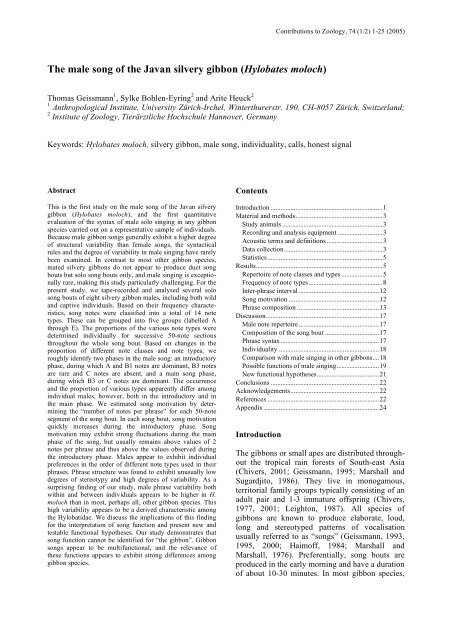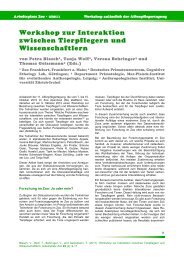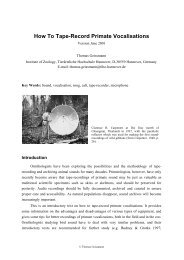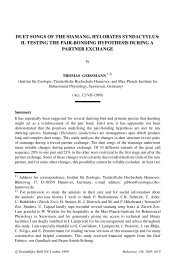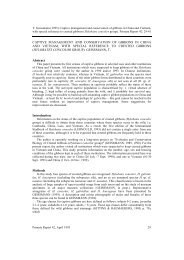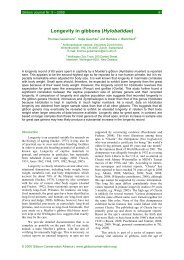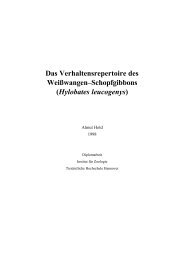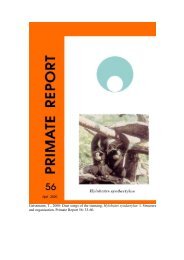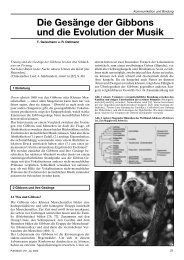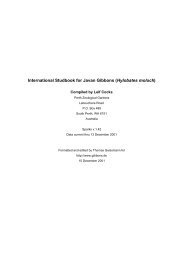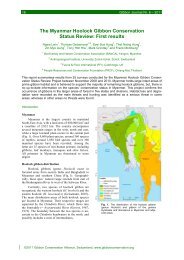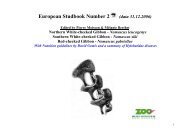The male song of the Javan silvery gibbon (Hylobates moloch)
The male song of the Javan silvery gibbon (Hylobates moloch)
The male song of the Javan silvery gibbon (Hylobates moloch)
- No tags were found...
Create successful ePaper yourself
Turn your PDF publications into a flip-book with our unique Google optimized e-Paper software.
Contributions to Zoology, 74 (1/2) 1-25 (2005)<strong>The</strong> <strong>male</strong> <strong>song</strong> <strong>of</strong> <strong>the</strong> <strong>Javan</strong> <strong>silvery</strong> <strong>gibbon</strong> (<strong>Hylobates</strong> <strong>moloch</strong>)Thomas Geissmann 1 , Sylke Bohlen-Eyring 2 and Arite Heuck 21 Anthropological Institute, University Zürich-Irchel, Winterthurerstr. 190, CH-8057 Zürich, Switzerland;2 Institute <strong>of</strong> Zoology, Tierärztliche Hochschule Hannover, GermanyKeywords: <strong>Hylobates</strong> <strong>moloch</strong>, <strong>silvery</strong> <strong>gibbon</strong>, <strong>male</strong> <strong>song</strong>, individuality, calls, honest signalAbstractThis is <strong>the</strong> first study on <strong>the</strong> <strong>male</strong> <strong>song</strong> <strong>of</strong> <strong>the</strong> <strong>Javan</strong> <strong>silvery</strong><strong>gibbon</strong> (<strong>Hylobates</strong> <strong>moloch</strong>), and <strong>the</strong> first quantitativeevaluation <strong>of</strong> <strong>the</strong> syntax <strong>of</strong> <strong>male</strong> solo singing in any <strong>gibbon</strong>species carried out on a representative sample <strong>of</strong> individuals.Because <strong>male</strong> <strong>gibbon</strong> <strong>song</strong>s generally exhibit a higher degree<strong>of</strong> structural variability than fe<strong>male</strong> <strong>song</strong>s, <strong>the</strong> syntacticalrules and <strong>the</strong> degree <strong>of</strong> variability in <strong>male</strong> singing have rarelybeen examined. In contrast to most o<strong>the</strong>r <strong>gibbon</strong> species,mated <strong>silvery</strong> <strong>gibbon</strong>s do not appear to produce duet <strong>song</strong>bouts but solo <strong>song</strong> bouts only, and <strong>male</strong> singing is exceptionallyrare, making this study particularly challenging. For <strong>the</strong>present study, we tape-recorded and analysed several solo<strong>song</strong> bouts <strong>of</strong> eight <strong>silvery</strong> <strong>gibbon</strong> <strong>male</strong>s, including both wildand captive individuals. Based on <strong>the</strong>ir frequency characteristics,<strong>song</strong> notes were classified into a total <strong>of</strong> 14 notetypes. <strong>The</strong>se can be grouped into five groups (labelled Athrough E). <strong>The</strong> proportions <strong>of</strong> <strong>the</strong> various note types weredetermined individually for successive 50-note sectionsthroughout <strong>the</strong> whole <strong>song</strong> bout. Based on changes in <strong>the</strong>proportion <strong>of</strong> different note classes and note types, weroughly identify two phases in <strong>the</strong> <strong>male</strong> <strong>song</strong>: an introductoryphase, during which A and B1 notes are dominant, B3 notesare rare and C notes are absent, and a main <strong>song</strong> phase,during which B3 or C notes are dominant. <strong>The</strong> occurrenceand <strong>the</strong> proportion <strong>of</strong> various types apparently differ amongindividual <strong>male</strong>s, however, both in <strong>the</strong> introductory and in<strong>the</strong> main phase. We estimated <strong>song</strong> motivation by determining<strong>the</strong> “number <strong>of</strong> notes per phrase” for each 50-notesegment <strong>of</strong> <strong>the</strong> <strong>song</strong> bout. In each <strong>song</strong> bout, <strong>song</strong> motivationquickly increases during <strong>the</strong> introductory phase. Songmotivation may exhibit strong fluctuations during <strong>the</strong> mainphase <strong>of</strong> <strong>the</strong> <strong>song</strong>, but usually remains above values <strong>of</strong> 2notes per phrase and thus above <strong>the</strong> values observed during<strong>the</strong> introductory phase. Males appear to exhibit individualpreferences in <strong>the</strong> order <strong>of</strong> different note types used in <strong>the</strong>irphrases. Phrase structure was found to exhibit unusually lowdegrees <strong>of</strong> stereotypy and high degrees <strong>of</strong> variability. As asurprising finding <strong>of</strong> our study, <strong>male</strong> phrase variability bothwithin and between individuals appears to be higher in H.<strong>moloch</strong> than in most, perhaps all, o<strong>the</strong>r <strong>gibbon</strong> species. Thishigh variability appears to be a derived characteristic among<strong>the</strong> Hylobatidae. We discuss <strong>the</strong> implications <strong>of</strong> this findingfor <strong>the</strong> interpretation <strong>of</strong> <strong>song</strong> function and present new andtestable functional hypo<strong>the</strong>ses. Our study demonstrates that<strong>song</strong> function cannot be identified for “<strong>the</strong> <strong>gibbon</strong>”. Gibbon<strong>song</strong>s appear to be multifunctional, and <strong>the</strong> relevance <strong>of</strong><strong>the</strong>se functions appears to exhibit strong differences among<strong>gibbon</strong> species.ContentsIntroduction ....................................................................1Material and methods.....................................................3Study animals .............................................................3Recording and analysis equipment ...........................3Acoustic terms and definitions ..................................3Data collection............................................................3Statistics ......................................................................5Results.............................................................................5Repertoire <strong>of</strong> note classes and types .........................5Frequency <strong>of</strong> note types.............................................8Inter-phrase interval .................................................12Song motivation .......................................................12Phrase composition ..................................................13Discussion.....................................................................17Male note repertoire .................................................17Composition <strong>of</strong> <strong>the</strong> <strong>song</strong> bout .................................17Phrase syntax ............................................................17Individuality .............................................................18Comparison with <strong>male</strong> singing in o<strong>the</strong>r <strong>gibbon</strong>s....18Possible functions <strong>of</strong> <strong>male</strong> singing..........................19New functional hypo<strong>the</strong>ses......................................21Conclusions ..................................................................22Acknowledgements......................................................22References ....................................................................22Appendix ......................................................................24Introduction<strong>The</strong> <strong>gibbon</strong>s or small apes are distributed throughout<strong>the</strong> tropical rain forests <strong>of</strong> South-east Asia(Chivers, 2001; Geissmann, 1995; Marshall andSugardjito, 1986). <strong>The</strong>y live in monogamous,territorial family groups typically consisting <strong>of</strong> anadult pair and 1-3 immature <strong>of</strong>fspring (Chivers,1977, 2001; Leighton, 1987). All species <strong>of</strong><strong>gibbon</strong>s are known to produce elaborate, loud,long and stereotyped patterns <strong>of</strong> vocalisationusually referred to as “<strong>song</strong>s” (Geissmann, 1993,1995, 2000; Haim<strong>of</strong>f, 1984; Marshall andMarshall, 1976). Preferentially, <strong>song</strong> bouts areproduced in <strong>the</strong> early morning and have a duration<strong>of</strong> about 10-30 minutes. In most <strong>gibbon</strong> species,
2 T. Geissmann et al. – <strong>The</strong> Male Song <strong>of</strong> <strong>the</strong> <strong>Javan</strong> Silvery Gibbonmated pairs utter <strong>the</strong>ir <strong>song</strong>s in <strong>the</strong> form <strong>of</strong> wellcoordinatedduets. In addition, mated <strong>male</strong>s <strong>of</strong> <strong>the</strong>lar group (genus <strong>Hylobates</strong>) may also produce<strong>male</strong> solo <strong>song</strong>s (Geissmann, 2002a).<strong>The</strong> <strong>Javan</strong> <strong>silvery</strong> <strong>gibbon</strong> (<strong>Hylobates</strong> <strong>moloch</strong>) isone <strong>of</strong> only two <strong>gibbon</strong> species not known toproduce duet <strong>song</strong>s (<strong>the</strong> o<strong>the</strong>r non-duettingspecies being H. klossii) (Geissmann, 2002a). Inaddition, H. <strong>moloch</strong> is particularly unusual amonghylobatids because most <strong>of</strong> <strong>the</strong> singing isproduced by fe<strong>male</strong>s (Geissmann and Nijman,2001; Kappeler, 1984a), and mated fe<strong>male</strong>sappear to be <strong>the</strong> vocal “ ’representative’ <strong>of</strong> <strong>the</strong>family” (Kappeler, 1984a). In all o<strong>the</strong>r <strong>gibbon</strong>s,ei<strong>the</strong>r <strong>the</strong> opposite is true or <strong>the</strong> amounts <strong>of</strong> <strong>male</strong>and fe<strong>male</strong> singing are about equal (Geissmann,2002a).Because <strong>male</strong> singing is exceptionally rare in<strong>silvery</strong> <strong>gibbon</strong>s, studying <strong>the</strong>se <strong>song</strong>s wasparticularly challenging. During 130 days inWestern Java, Kappeler heard none <strong>of</strong> his fivestudy group <strong>male</strong>s produce a <strong>song</strong> and concluded“it thus appears that territorial <strong>male</strong> <strong>moloch</strong><strong>gibbon</strong>s do not sing” (Kappeler, 1984a, p. 386).<strong>The</strong> only <strong>male</strong> <strong>song</strong> Kappeler heard in his studyarea was produced by a solitary <strong>male</strong> singing on<strong>the</strong> common territory boundary <strong>of</strong> two residentgroups. Ano<strong>the</strong>r similar <strong>song</strong> bout was heardoutside <strong>of</strong> <strong>the</strong> study area. More recent observationsin Central Java revealed that territorial<strong>male</strong>s do sing, albeit rarely (Geissmann andNijman, 2001). <strong>The</strong>se authors heard choruses <strong>of</strong><strong>male</strong> <strong>silvery</strong> <strong>gibbon</strong> <strong>song</strong> bouts occurring aboutonce each week on average and usually beforedawn. Male <strong>song</strong>s usually ended before <strong>the</strong>fe<strong>male</strong>s started <strong>the</strong>ir <strong>song</strong> bouts at around dawn.Acoustic individuality has been demonstratedto exist in several <strong>gibbon</strong> species (Dallmann andGeissmann, 2001a, b; Haim<strong>of</strong>f and Gittins, 1985;Haim<strong>of</strong>f and Tilson, 1985), but <strong>the</strong>se studies havebeen restricted to fe<strong>male</strong> singing. Fe<strong>male</strong> <strong>song</strong>s,as a rule, are more stereotyped than <strong>male</strong> <strong>song</strong>s(Geissmann, 1995, 2002a) and, <strong>the</strong>refore, easier toanalyse.<strong>The</strong> elusive <strong>male</strong> <strong>song</strong> <strong>of</strong> H. <strong>moloch</strong> has notpreviously been analysed quantitatively. All weknow <strong>of</strong> <strong>the</strong> <strong>song</strong> is based on short verbaldescriptions supplemented with few shortsonagrams (Kappeler, 1984a; Geissmann andNijman, 2001). An additional <strong>song</strong> <strong>of</strong> a captive<strong>male</strong> has been described by Haim<strong>of</strong>f (1983), butthis individual was later identified as a Bornean<strong>gibbon</strong> (H. muelleri) (Geissmann, 2002a).In this study, we describe <strong>the</strong> syntax <strong>of</strong> <strong>the</strong><strong>silvery</strong> <strong>gibbon</strong> <strong>male</strong> <strong>song</strong> based on tape-recorded<strong>song</strong>s <strong>of</strong> several captive and wild individuals. Wecompare <strong>the</strong> variability <strong>of</strong> <strong>male</strong> <strong>song</strong> structurewithin and between individuals. Our results canbe used as a baseline for future studies onindividuality in <strong>male</strong> <strong>gibbon</strong> singing, because <strong>the</strong>syntax and variability <strong>of</strong> <strong>male</strong> solo <strong>song</strong>s haveapparently not been studied quantitatively in arepresentative sample <strong>of</strong> individuals for any o<strong>the</strong>r<strong>gibbon</strong> species.Table 1. Origin, number <strong>of</strong> individuals and <strong>song</strong> bouts, and recording information <strong>of</strong> <strong>the</strong> material analysed in this study.Recording a Recording Date Individual Author <strong>of</strong> Recording Duration <strong>of</strong>RecordingCompleteness <strong>of</strong>Song BoutHalimun 23 Nov. 1998 “Halimun” B. Merker 14 min 43 s NoHowletts 1 17 Oct. 1988 “Omar” T. Geissmann 38 min 46 s YesHowletts 2 18 June 1995 “Hilo” T. Geissmann 35 min 52 s Yes bHowletts 3 28 Aug. 1999 “Lupau” S. Bohlen-Eyring 14 min 42 s YesJakarta 1a 8 June 1978 “Jakarta 1” M. Kappeler 7 min 31 s NoJakarta 1b 7 June 1978 “Jakarta 1” M. Kappeler 8 min 26 s NoJakarta 2 28 Jan. 2001 “Jakarta 2” T. Geissmann 40 min 45 s NoKalejetan 25 Aug.1978 “Kalejetan” M. Kappeler 2 min 17 s NoMunich 1a 21 June 1988 “Paul” T. Geissmann 12 min 15 s Yes cMunich 1b 17 Oct. 1991 “Paul” T. Geissmann 21 min 03 s YesMunich 1c 28 April 1995 “Paul” T. Geissmann 20 min 02 s YesabcRecording localities are described in <strong>the</strong> text.Song aborted upon <strong>the</strong> start <strong>of</strong> a solo <strong>song</strong> by <strong>the</strong> neighbouring fe<strong>male</strong> H. <strong>moloch</strong>.Song aborted upon <strong>the</strong> start <strong>of</strong> a solo <strong>song</strong> by <strong>the</strong> neighbouring fe<strong>male</strong> Nomascus leucogenys.
Contributions to Zoology, 74 (1/2) – 2005 3Material and methodsStudy animalsWe analysed a total <strong>of</strong> 11 <strong>male</strong> <strong>song</strong> bouts from 8different H. <strong>moloch</strong> <strong>male</strong>s, as listed in Table 1.Tape-recordings were carried out at <strong>the</strong> followinglocalities: (1) Howletts Zoo Park, Canterbury,United Kingdom; (2) Hellabrunn Zoo, Munich,Germany; (3) Ragunan Zoo, Jakarta, Java, Indonesia;(4) Kalejetan, Ujung-Kulon National Park,West Java, Indonesia; (5) Cikaniki ResearchStation, Gunung Halimun, West Java, Indonesia.<strong>The</strong> latter two recordings were made on wild<strong>silvery</strong> <strong>gibbon</strong>s. In addition, one <strong>of</strong> us (TG) madeseveral tape-recordings <strong>of</strong> <strong>male</strong> <strong>song</strong>s in LinggoAsri (Dieng Plateau, Central Java). Because <strong>of</strong> <strong>the</strong>large distance between <strong>the</strong> observer and <strong>the</strong><strong>gibbon</strong>s, <strong>the</strong>se latter tapes were not analysed indetail, but only used for qualitative comparisons,as were additional tape-recorded <strong>male</strong> <strong>song</strong>s fromMunich and Howletts.Recording and analysis equipmentGibbon <strong>song</strong>s were recorded with SONY WM-D5M and SONY WM-D6C cassette recordersequipped with Sennheiser ME80(+K3U) and JVCMZ-707 directional microphones by us, with aUHER REPORT 4200 tape recorder and a NIVICOIVC directional microphone by M. Kappeler, andwith a SONY TDC-D8 DAT-recorder and twoSONY elektret microphones equipped withparabolic reflectors by B. Merker.<strong>The</strong> sound material was digitised with a samplerate <strong>of</strong> 11 kHz and a sample size <strong>of</strong> 16 bit. Timeversus frequency displays (sonagrams) <strong>of</strong> taperecordedvocalisations were generated using <strong>the</strong>Canary s<strong>of</strong>tware version 1.2.4 on an Applepersonal computer (Power Macintosh G3). <strong>The</strong>FFT (Fast Fourier Transformation) size <strong>of</strong> <strong>the</strong>sonagrams was 2048 points with an overlap <strong>of</strong>75% and a frame length <strong>of</strong> 1024 points (frequencyresolution = 5.383 Hz) (Charif et al., 1995).Acoustic terms and definitionsA note is defined as “any single continuous sound<strong>of</strong> any distinct frequency (pitch) or frequency modulation,which may be produced by ei<strong>the</strong>r an inhaledor exhaled breath” (Haim<strong>of</strong>f, 1984, p. 335).Song notes may occur ei<strong>the</strong>r single or in moreor less brief series, which are termed phrases andfigures here. A phrase is a larger, loose collection<strong>of</strong> several notes preferentially uttered in combination.Intra-phrase intervals are, by definition,shorter than inter-phrase intervals. Short, stereotypedsets <strong>of</strong> notes which may facultatively occurwithin phrases are termed figures (sensu Haim<strong>of</strong>f,1984).A <strong>song</strong> is what fulfils <strong>the</strong> criteria set forth byThorpe (1961, p. 15): “What is usually understoodkHz2Note durationNote duration10MaximumfrequencyStartfrequency= MinimumfrequencyEndfrequencyMaximumfrequencyStartfrequencyabEndfrequencyMinimumfrequency0 24 6 sFig. 1. Sonagram <strong>of</strong> two <strong>male</strong> <strong>song</strong> notes (a wa note and a chevron note), illustrating <strong>the</strong> measurements taken during this study.In <strong>the</strong> chevron note, “a” indicates <strong>the</strong> main or chevron part <strong>of</strong> <strong>the</strong> note, and “b” indicates <strong>the</strong> facultative end part.
4 T. Geissmann et al. – <strong>The</strong> Male Song <strong>of</strong> <strong>the</strong> <strong>Javan</strong> Silvery GibbonTable 2. Note measurements determined during <strong>the</strong> present study. Each cell includes mean value ± standard deviation, range,number <strong>of</strong> individuals and (in paren<strong>the</strong>sis) <strong>the</strong> total number <strong>of</strong> notes measured (Individuals included: Halimun, Howletts 1,Howletts 2, Jakarta 1, Jakarta 2, Kalejetan, Munich).NotetypeDuration (s) Start frequency (kHz) End frequency (kHz) Minimum frequency(kHz)A 0.178 ± 0.075 0.647 ± 0.066 0.675 ± 0.133 0.593 ± 0.0750.106 - 0.450 0.529 - 0.758 0.388 - 0.952 0.388 - 7037 (20)7 (20)7 (20)7 (20)B1 0.252 ± 0.068 0.630 ± 0.040 0.884 ± 0.072 0.627 ± 0.0390.151 - 0.410 0.551 - 0.700 0.777 - 0.998 0.551 - 07006 (18)6 (18)6 (18)6 (18)B2 0.294 ± 0.0450.222 - 0.3866 (18)B3 0.305 ± 0.0560.240 - 0.4855 (15)B4 0.259 ± 0.0600.142 - 0.3745 (15)C1 0.486 ± 0.1270.309 - 0.7226 (16)C2 0.511 ± 0.1190.317 - 0.7156 (17)C3 0.834 ± 0.1370.560 - 1.0966 (18)C4 0.778 ± 0.1560.616 - 1.0715 (15)C5 0.712 ± 0.0870.541 - 0.7703 (7)C6 0.757 ± 0.0930.608 - 0.9144 (12)C7 0.652 ± 0.1110.475 - 0.8596 (16)D 0.621 ± 0.2130.339 - 0.9124 (10)E 0.238 ± 0.0930.114 - 0,4046 (16)0.642 ± 0.0460.539 - 0.7006 (18)0.659 ± 0.0480.537 - 0.7005 (15)0.772 ± 0.0520.714 - 0.8905 (15)0.705 ± 0.0940.529 - 0.8496 (16)0.748 ± 0.1130.558 - 0.9806 (17)0.715 ± 0.1030.558 - 0.9106 (18)0.725 ± 0.1220.606 - 1.0245 (15)0.672 ± 0.0840.611 - 0.8493 (7)0.692 ± 0.1040.551 - 0.9504 (12)0.68 ± 0.1010.510 - 0.8366 (16)0.718 ± 0.0720.600 - 0.8024 (10)0.968 ± 0.160.710 - 1.2326 (16)1.152 ± 0.0811.010 - 1.2586 (18)1.298 ± 0.1091.070 - 1.5145 (15)1.110 ± 0.2090.824 - 1.5375 (15)0.673 ± 0.0940.520 - 0.8446 (16)0.719 ± 0.1100.558 - 0.9806 (17)0.787 ± 0.1490.558 - 1.0826 (18)0.692 ± 0.0970.534 - 0.8395 (15)1.135 ± 0.1740.922 - 1.3533 (7)0.880 ± 0.1990.581 - 1.1774 (12)0.674 ± 0.1210.530 - 0.9566 (16)0.682 ± 0.1160.443 - 0.8144 (10)0.810 ± 0.1540.577 - 1.1146 (16)0.641 ± 0.0460.539 - 0.7006 (18)0.657 ± 0.0480.537 - 0.7005 (15)0.771 ± 0.0530.714 - 0.8905 (15)0.654 ± 0.0790.520 - 0.7996 (16)0.701 ± 0.0980.558 - 0.9186 (17)0.672 ± 0.0740.558 - 0.8096 (18)0.655 ± 0.0780.534 - 0.8105 (15)0.668 ± 0.0850.611 - 0.8493 (7)0.672 ± 0.0760.551 - 0.7724 (12)0.632 ± 0.0850.510 - 0.8296 (16)0.649 ± 0.0930.443 - 0.7654 (10)0.808 ± 0.1530.577 - 1.1146 (16)Maximum frequency(kHz)0.714 ± 0.0940.529 - 0.9527 (20)0.896 ± 0.0710.784 - 0.9986 (18)1.173 ± 0.0881.010 - 1.2786 (18)1.380 ± 0.0731.301 - 1.5225 (15)1.151 ± 0.1990.875 - 1.5375 (15)0.955 ± 0.0330.890 - 1.0006 (16)1.199 ± 0.2800.756 - 2.0016 (17)1.264 ± 0.2940.758 - 1.9906 (18)1.233 ± 0.1710.994 - 1.5515 (15)1.321 ± 0.3270.982 - 1.9703 (7)1.136 ± 0.3610.102 - 1.4734 (12)1.077 ± 0.1740.879 - 1.4446 (16)0.801 ± 0.0940.600 - 0.8954 (10)1.064 ± 0.1690.794 - 1.3256 (16)by <strong>the</strong> term <strong>song</strong> is a series <strong>of</strong> notes, generally <strong>of</strong>more than one type, uttered in succession and sorelated as to form a recognisable sequence orpattern in time”, or, a <strong>song</strong> is a succession <strong>of</strong>phrases with non-random succession probability(“Strophenfolgen mit nicht-zufälliger Folgewahrscheinlichkeit”,Tembrock, 1977, p. 33). Songbouts are separated from each o<strong>the</strong>r by anarbitrarily defined interval <strong>of</strong> at least 5 minutes.Some authors have referred to individualphrases within a <strong>song</strong> bout as “<strong>song</strong>s” (e.g.Marshall and Sugardjito, 1986). We follow Geissmann’s(2000) recommendation using <strong>the</strong> term“phrase” instead, in order to make it clear whe<strong>the</strong>rone is talking about a mere collection <strong>of</strong> notes(usually shorter than 1 minute), or about a <strong>song</strong>bout (i.e. a collection <strong>of</strong> phrases, with an overallduration <strong>of</strong> several minutes).
6 T. Geissmann et al. – <strong>The</strong> Male Song <strong>of</strong> <strong>the</strong> <strong>Javan</strong> Silvery Gibbonfined and described below. Duration andfrequency measurements were taken on threerepresentative notes <strong>of</strong> each note type per individual.Summary measurements (mean, standarddeviation, range) are presented in Table 2. Inaddition, <strong>the</strong> table lists <strong>the</strong> number <strong>of</strong> <strong>gibbon</strong>s and<strong>the</strong> number <strong>of</strong> notes that were available for <strong>the</strong>measurements. Because not all individuals useevery note type in <strong>the</strong>ir <strong>song</strong> bouts, <strong>the</strong> number <strong>of</strong>individuals studied may differ between note typesin <strong>the</strong> table. Typical sonagrams <strong>of</strong> all note typesand classes are shown in Figure 2.Based on <strong>the</strong>ir different mechanisms <strong>of</strong>utterance, we first differentiate between expirationnotes and inspiration notes (i.e. notes which areproduced during exhalation and during breathintake, respectively). As <strong>the</strong>re is no intermediateoption between <strong>the</strong>se two forms <strong>of</strong> vocalisation,<strong>the</strong> two forms cannot, by definition, grade intoeach o<strong>the</strong>r and are, <strong>the</strong>refore, identified as twodifferent note classes. Expiration notes represent<strong>the</strong> large majority <strong>of</strong> <strong>the</strong> <strong>song</strong> repertoire.Expiration notes can be fur<strong>the</strong>r divided in anumber <strong>of</strong> note types. <strong>The</strong>y represent a gradedsystem, and intermediate forms can be foundamong <strong>the</strong> different types. Yet, because someforms are particularly common, we identified<strong>the</strong>m as different note types, although <strong>the</strong>sedivisions remain arbitrary. Based on similarity,expiration note types are combined into four basicgroups: oo notes (1 type), wa notes (4 types),chevron notes (7 types) and variable notes (1type). Only one type <strong>of</strong> inspiration note isrecognised in this study.Oo notes<strong>The</strong> oo notes (Type A) are <strong>the</strong> most simple expirationnotes in <strong>the</strong> <strong>male</strong> <strong>song</strong> repertoire, exhibiting<strong>the</strong> lowest intensity, <strong>the</strong> shortest duration (0.2±0.1s) and <strong>the</strong> smallest amount <strong>of</strong> frequencymodulation (Figure 2). <strong>The</strong> fundamental frequencyis below 1 kHz. Oo notes exhibit only amoderate amount <strong>of</strong> frequency modulation, but<strong>the</strong> note shape in <strong>the</strong> sonagram is very variable:We found oo notes <strong>of</strong> increasing, decreasing orstable frequency. More complex sonagramstructures – such as u-shaped or n-shaped notes ornotes which begin with stable frequency butsharply go down at <strong>the</strong> end <strong>of</strong> <strong>the</strong> note – alsooccur. Oo notes are preferentially uttered at <strong>the</strong>beginning <strong>of</strong> <strong>the</strong> <strong>male</strong> <strong>song</strong> bout, but also occurduring mild disturbances and moderate excitementoutside <strong>of</strong> <strong>the</strong> <strong>song</strong> context.During <strong>song</strong> bouts, notes may gradually changefrom oo notes into wa notes (see below).Wa notesFollowing Kappeler (1984a), <strong>the</strong> most commongroup <strong>of</strong> expiration notes are termed wa notes.<strong>The</strong>y are short like, but louder than, oo notes andcharacterised by a fast frequency increase. Startingfrequency and minimum frequency alwayscoincide in wa notes. After reaching <strong>the</strong> maximumfrequency near <strong>the</strong> end <strong>of</strong> <strong>the</strong> note, a terminalfrequency decrease is absent or slight, amountingto less than half <strong>of</strong> <strong>the</strong> preceding frequencyincrease. Wa notes are very variable in <strong>the</strong>ir endand maximum frequencies. We distinguish betweenfour different note types (Figures 2), whichwe term B1, B2, B3 and B4 in <strong>the</strong> following text.Note type B1 comprises wa notes <strong>of</strong> relativelymoderate frequency modulation. Notes have astarting frequency <strong>of</strong> about 0.7 kHz or below, andreach a maximum frequency <strong>of</strong> 1 kHz or less.Note type B2 resembles B1, but <strong>the</strong> maximumfrequency ranges from above 1 kHz up to 1.3 kHz.Note type B3 comprises <strong>the</strong> wa notes with <strong>the</strong>highest amount <strong>of</strong> frequency modulation. Thisnote type resembles B1, but <strong>the</strong> maximumfrequency ranges from above 1.3 kHz to about 1.5kHz. Note type B4 includes wa notes with arelatively high starting frequency (i.e. above 0.7kHz). <strong>The</strong> maximum frequency is variable and canrise to about 1.5 kHz.<strong>The</strong> trill is a particularly stereotyped figure (i.e.a <strong>song</strong> unit intermediate between single notes andphrases). Trills are short bursts <strong>of</strong> three to five B1notes with very short intervals. Often, <strong>the</strong> trillexhibits a distinct decrease in minimum frequency,maximum frequency and frequency rangefrom <strong>the</strong> first to <strong>the</strong> last trill note. Individual trillnotes may or may not be followed by inspirationnotes (described below). Trills usually are precededby a B2 or B3 note, also with facultativeinspiration note.Chevron notes<strong>The</strong> third group <strong>of</strong> note types comprises thosenotes which have been termed wa-oo and wa-oowanotes by Kappeler (1984 a) and are referred toas chevron notes in <strong>the</strong> present study. Allchevrons begin with rising frequency, <strong>the</strong>n, afterreaching a peak, frequency decreases again.Chevron notes differ in <strong>the</strong>ir frequency structure
Contributions to Zoology, 74 (1/2) – 2005 7and duration. Based on <strong>the</strong>ir shape in <strong>the</strong>sonagram, some chevron notes exhibit two distinctparts. <strong>The</strong> first part <strong>of</strong> <strong>the</strong> note (a) consists <strong>of</strong> <strong>the</strong>chevron proper described above. <strong>The</strong> second part(b) is <strong>the</strong> drawn-out tail <strong>of</strong> <strong>the</strong> chevron (Figure 1).<strong>The</strong> tail’s frequency structure is particularlyvariable. Chevron notes are introduced relativelylate during <strong>the</strong> <strong>song</strong> bout, after <strong>the</strong> wa notes.Chevron notes represent <strong>the</strong> most characteristicvocalisations in <strong>the</strong> <strong>song</strong> <strong>of</strong> <strong>male</strong> <strong>silvery</strong> <strong>gibbon</strong>s,but are absent or very rare in fe<strong>male</strong> <strong>song</strong> bouts.Individual <strong>male</strong>s appear to differ strongly in <strong>the</strong>iruse <strong>of</strong> chevron notes in general and <strong>of</strong> certaintypes <strong>of</strong> chevron notes in particular. Wedifferentiate between seven types <strong>of</strong> chevron notesin H. <strong>moloch</strong> (Figure 2), which we term C1, C2,C3 and so on in <strong>the</strong> following text.Note type C1 is <strong>of</strong> a simple chevron form in <strong>the</strong>sonagram; a tail end is absent. This note typereaches a maximum frequency <strong>of</strong> 1 kHz or less.Note type C2 resembles C1, but its maximumfrequency is situated above 1 kHz. Note type C3 isa chevron with a tail end. <strong>The</strong> latter is <strong>of</strong> chevronform, too, with its own peak frequency. After <strong>the</strong>tail peak, <strong>the</strong> frequency descends to about <strong>the</strong>starting level for <strong>the</strong> second time. Note type C4resembles C3, but <strong>the</strong> frequency remains nearlyunmodulated in <strong>the</strong> tail end. Note type C5 also is achevron with a tail end. After reaching <strong>the</strong> firstpeak <strong>of</strong> <strong>the</strong> chevron, <strong>the</strong> frequency descends onlymoderately and does not reach <strong>the</strong> level <strong>of</strong> <strong>the</strong>starting frequency. In <strong>the</strong> tail end, <strong>the</strong> frequencyrises again and reaches or even surpasses <strong>the</strong>maximum frequency <strong>of</strong> <strong>the</strong> first peak. Note typeC6 resembles C5, but <strong>the</strong> frequency rise in <strong>the</strong> tailend is more moderate and does not reach <strong>the</strong>maximum frequency <strong>of</strong> <strong>the</strong> first peak. Note typeC7 is a simple chevron resembling C2, but <strong>the</strong>frequency decrease occurs much more slowly than<strong>the</strong> initial increase.Variable notes<strong>The</strong> fourth group is termed variable notes andincludes only one note type, D. It comprises allexpiration notes which are nei<strong>the</strong>r wa notes norchevron notes. Notes <strong>of</strong> this type are extremelyvariable (Figure 2). Fur<strong>the</strong>r partitioning <strong>of</strong> thisgroup would easily be possible but was not founduseful considering its rarity in <strong>the</strong> <strong>song</strong> bout.Variable notes are long (0.6±0.2 s) and <strong>of</strong> verymoderate frequency modulation (0.3 kHz or less).<strong>The</strong> direction <strong>of</strong> <strong>the</strong> frequency modulation isvariable; <strong>the</strong> frequency may rise, drop or changerepeatedly.<strong>The</strong> variable figure (Figure 2) is not a singlenote, but a cluster <strong>of</strong> more than three notes, wi<strong>the</strong>xtremely short intervals and with a total duration<strong>of</strong> 1.5±0.3 s. All note types <strong>of</strong> <strong>the</strong> <strong>male</strong> <strong>song</strong>repertoire may occur in <strong>the</strong>se rapid notesequences, but variable notes and inspiration notesare most prominent. Both <strong>the</strong> degree and <strong>the</strong>direction <strong>of</strong> frequency modulations are veryvariable in <strong>the</strong>se figures. Intervals may be so shortthat <strong>the</strong> number <strong>of</strong> individual notes uttered in aseries can sometimes not be determined reliably.<strong>The</strong>refore, variable figures were not broken downinto single notes for <strong>the</strong> note counts <strong>of</strong> this study(see below) but simply recorded as one unit.Inspiration notesThis note class also is variable in its frequencystructure, but most commonly exhibits an ei<strong>the</strong>rdecreasing or chevron shape. Despite <strong>the</strong>structural variability <strong>of</strong> inspiration notes, only onetype is recognised here (type E). A fur<strong>the</strong>rpartitioning <strong>of</strong> this class did not appear to beuseful because <strong>of</strong> its rarity. Often, an inspirationnote immediately follows a wa note (forming a socalledwa-aa figure), or appears to link twoexpiration notes toge<strong>the</strong>r (forming a wa-aa-wafigure). In <strong>the</strong>se figures, intervals between notesare very short (<strong>the</strong> second sonagram <strong>of</strong> an E notein Figure 2 shows a typical wa-aa-wa figure).Particularly fast alternations <strong>of</strong> B1 and E notes canoccur in trill figures (described above). Inspirationnotes are <strong>of</strong>ten less loud than <strong>the</strong> accompanyingwa notes. <strong>The</strong> so-called variable figures (seeabove) may also include inspiration notes.Individuality in <strong>the</strong> note repertoireNot all note types were used by all <strong>male</strong>s (at leastnot in <strong>the</strong> <strong>song</strong> material available for this study),as listed in Table 3. For instance, <strong>the</strong> Howletts 2<strong>male</strong> was lacking types C4 and C5, Howletts 3was lacking C3, C4, C5, and C6, and <strong>the</strong> <strong>song</strong>bout <strong>of</strong> <strong>the</strong> Halimun <strong>male</strong> did not include notetype D. Similarly, <strong>the</strong> variable figure did not occurin <strong>the</strong> <strong>song</strong> <strong>of</strong> <strong>the</strong> Howletts 3 and Halimun <strong>male</strong>s.Trill figures were even less common. As a regularcomponent <strong>of</strong> <strong>the</strong> <strong>song</strong> repertoire, <strong>the</strong>y onlyoccurred in <strong>the</strong> <strong>song</strong> <strong>of</strong> <strong>the</strong> Jakarta 2 <strong>male</strong>. <strong>The</strong>y
8 T. Geissmann et al. – <strong>The</strong> Male Song <strong>of</strong> <strong>the</strong> <strong>Javan</strong> Silvery Gibbonoccurred infrequently in <strong>the</strong> <strong>song</strong>s <strong>of</strong> <strong>the</strong> Munich<strong>male</strong>, and only one poorly-expressed trill wasfound in <strong>the</strong> <strong>song</strong> <strong>of</strong> <strong>the</strong> Howletts 1 <strong>male</strong>.Frequency <strong>of</strong> note types<strong>The</strong> frequency distributions <strong>of</strong> <strong>the</strong> various notetypes provide first insights into <strong>the</strong> rules by which<strong>male</strong> <strong>silvery</strong> <strong>gibbon</strong>s build up <strong>the</strong>ir <strong>song</strong> bouts. Asshown below, at least two distinct phases canroughly be distinguished in <strong>the</strong> <strong>male</strong> <strong>song</strong> bout: abuild-up or introductory phase and a main phase.In order to monitor changes in <strong>the</strong> proportion <strong>of</strong>notes types in various stages <strong>of</strong> a <strong>male</strong> <strong>song</strong> bout,we divided each <strong>song</strong> bout in 50-note segmentsand determined <strong>the</strong> proportion <strong>of</strong> all note types foreach segment. Not all segments comprise exactly50 notes, because we avoided splitting phrases(described below) into different segments. A andB1 notes were pooled in this part <strong>of</strong> <strong>the</strong> analysis.Figure 3 shows <strong>the</strong> relative frequency <strong>of</strong> allnote types in <strong>the</strong> course <strong>of</strong> <strong>song</strong> bouts <strong>of</strong> our studyanimals. <strong>The</strong> <strong>song</strong> bouts <strong>of</strong> <strong>the</strong> Halimun, Jakarta1, Jakarta 2 and Kalejetan <strong>male</strong>s were nottape-recorded in <strong>the</strong>ir entirety and may lack <strong>the</strong>build-up phase <strong>of</strong> <strong>the</strong> <strong>song</strong> bout. In order to facilitatecomparison, <strong>the</strong> frequency distributions <strong>of</strong> <strong>the</strong>incomplete <strong>song</strong> bouts are shown in separate parts<strong>of</strong> Figure 3.<strong>The</strong> proportion <strong>of</strong> most note types changesmarkedly during <strong>the</strong> <strong>song</strong> bout. <strong>The</strong> amount anddirection <strong>of</strong> <strong>the</strong>se changes differ among notetypes. <strong>The</strong> proportion <strong>of</strong> note types A+B1, forinstance, tends to decrease during <strong>song</strong> bouts.Whereas <strong>the</strong>se two note types make up between37 - 92% <strong>of</strong> <strong>the</strong> first 50 notes in <strong>the</strong> introductoryphase <strong>of</strong> all completely-recorded <strong>song</strong> bouts, <strong>the</strong>proportion decreases during <strong>the</strong> course <strong>of</strong> <strong>the</strong> <strong>song</strong>to levels below 20% and eventually approaches oreven reaches zero, although <strong>the</strong> proportion may goup again towards <strong>the</strong> end <strong>of</strong> <strong>the</strong> <strong>song</strong> (Howletts 3)or fluctuate around 15% during <strong>the</strong> second half <strong>of</strong><strong>the</strong> <strong>song</strong> bout (Howletts 2). In <strong>the</strong> incompletelyrecorded <strong>song</strong> bouts, this trend cannot berecognised clearly, because <strong>the</strong> build-up part ispartly or completely missing. Yet, a decrease in<strong>the</strong> proportions <strong>of</strong> note types A+B1 can also beobserved in each <strong>of</strong> <strong>the</strong> incomplete <strong>song</strong> boutsexcept in <strong>the</strong> Jakarta 2 <strong>male</strong>, which exhibits strongfluctuations around 15% in <strong>the</strong>se note proportionsduring <strong>the</strong> whole tape-recording.<strong>The</strong> proportion <strong>of</strong> note type B2 also tends todecrease somewhat during <strong>the</strong> course <strong>of</strong> <strong>the</strong> <strong>song</strong>bout, but <strong>the</strong> decrease is less pronounced than innote types A+B1, and <strong>the</strong> proportion appears toexhibit strong individual differences. During <strong>the</strong>Table 3. Occurrence <strong>of</strong> note types and some figures in <strong>the</strong> <strong>song</strong>s <strong>of</strong> each study animal, based on all available tape-recordedmaterial. aNote Halimun Howletts 1 Howletts 2 Howletts 3 Jakarta 1 Jakarta 2 Kalejetan c Munichtype bA + + + + + + + +B1 + + + + + + + +B2 + + + + + + + +B3 + + + + + + + +B4 + + + + (+) – + +C1 + + + + + + + +C2 + + + + + + + +C3 + + + + + + + +C4 (+) + (+) + + (+) + +C5 (+) + – – (+) + + –C6 + – + – + + + +C7 + + + + + + + +D – + + + + (+) + (+)E + + + + + + + +FiguretypeTrill f. – (+) – – – + – (+)Variablef.– + + – + + – (+)a Symbols: + = present, (+) = very rare, less than 0.5% <strong>of</strong> <strong>the</strong> <strong>song</strong> notes, – = absentb f. = figurec Absence <strong>of</strong> some note types in this <strong>male</strong> may be due to <strong>the</strong> shortness <strong>of</strong> <strong>the</strong> tape-recorded <strong>song</strong> excerpt (2min 17s, see Table 1).
Contributions to Zoology, 74 (1/2) – 2005 9first 200 notes, <strong>the</strong> average proportions for Howletts1, Howletts 3 and Munich are at 30 - 42%,whereas <strong>the</strong> averages are lower in <strong>the</strong> remainder<strong>of</strong> <strong>the</strong> <strong>song</strong> bout (27-34%). In <strong>the</strong> Howletts 2<strong>male</strong>, however, this note type remains virtuallyabsent during <strong>the</strong> first quarter <strong>of</strong> <strong>the</strong> <strong>song</strong> bout.Only later, <strong>the</strong> proportion rises to an average level<strong>of</strong> about 10%, and a maximum value <strong>of</strong> 22% isreached only in <strong>the</strong> last third <strong>of</strong> <strong>the</strong> <strong>song</strong> bout. In<strong>the</strong> available <strong>song</strong> excerpts <strong>of</strong> <strong>the</strong> Jakarta 1 <strong>male</strong>,on <strong>the</strong> o<strong>the</strong>r hand, B2 notes proportions exhibit anaverage level <strong>of</strong> about 50% and never decreasebelow 45%.In contrast to A, B1 and B2 notes, <strong>the</strong> proportion<strong>of</strong> B3 notes continually rises during <strong>the</strong>course <strong>of</strong> most <strong>song</strong> bouts. Whereas this note typemakes up less than 2% at <strong>the</strong> beginning <strong>of</strong> <strong>the</strong><strong>song</strong> bout, its proportion usually rises to a value <strong>of</strong>more than 20% within <strong>the</strong> first 400 notes <strong>of</strong> <strong>the</strong><strong>song</strong> bout (Howletts 1, Howletts 3, Munich) orlater (Howletts 2). <strong>The</strong> increase in note type B3appears to correlate with <strong>the</strong> decrease in note typeB1.<strong>The</strong> appearance <strong>of</strong> chevron notes appears tocoincide with <strong>the</strong> increase <strong>of</strong> <strong>the</strong> B3 note proportionand <strong>the</strong> decrease <strong>of</strong> <strong>the</strong> B1 note proportion.Chevron or C notes are never produced at <strong>the</strong>beginning <strong>of</strong> a <strong>song</strong> bout (exception: 4% inHowletts 1). <strong>The</strong> proportion <strong>of</strong> C notes rises tohigher levels within <strong>the</strong> first 250-400 notes. <strong>The</strong>sehigher levels appear to be strongly individualspecific,ranging from about 10% (Howletts 1,Howletts 2, Halimun), 17% (Munich), 20%(Howletts 3), 25% (Jakarta 1), 57% (Kalejetan), to70% (Jakarta 2). <strong>The</strong> respective proportions <strong>of</strong> <strong>the</strong>various variants <strong>of</strong> chevron notes (C1 - C7) do notsurpass 15%, except C3 notes in <strong>the</strong> Jakarta 2<strong>male</strong> (20%).<strong>The</strong> o<strong>the</strong>r note types defined in this study (B4,D and E) are much less common and, <strong>the</strong>refore,exhibit less obvious trends in <strong>the</strong>ir frequencydistribution during <strong>the</strong> <strong>song</strong> bout. In contrast tonote types A+B1, B2 , B3 and C, <strong>the</strong>ir proportionsrarely increase above 20%. Notable exceptions are<strong>the</strong> high proportions <strong>of</strong> B4 notes in Howletts 2 andHalimun, and <strong>of</strong> inspiration or E notes in <strong>the</strong>Halimun <strong>male</strong>, which amounts to an average <strong>of</strong>19% for <strong>the</strong> whole tape-recording and whichreaches a maximum value <strong>of</strong> 34% before <strong>the</strong> end<strong>of</strong> <strong>the</strong> <strong>song</strong> bout. In <strong>the</strong> complete <strong>song</strong> bouts,inspiration notes are rare or absent at <strong>the</strong> beginning,and <strong>the</strong>ir frequency slightly increases withincreasing <strong>song</strong> activity.Males also appear to differ in <strong>the</strong>ir preferencesfor certain chevron notes (Table 4). For example,note type C6 was a preferred chevron type <strong>of</strong>Howletts <strong>male</strong> 2 but was never produced byHowletts <strong>male</strong>s 1 and 3.10080Howletts 1Howletts 2Howletts 3Munich (Mean)8060Howletts 1Howletts 2Howletts 3Munich (Mean)6040Percent note type A+B1402006040Jakarta 1 (Mean)Jakarta 2HalimunKalejetanPercent note type B2200806040Jakarta 1 (Mean)Jakarta 2HalimunKalejetan202000 200 400 600 800 1000 1200 1400 1600Rank <strong>of</strong> note in <strong>song</strong> boutFig. 3. Changing proportions <strong>of</strong> different note types in consecutive50-note sections <strong>of</strong> <strong>the</strong> <strong>male</strong> <strong>song</strong> bouts <strong>of</strong> <strong>Hylobates</strong><strong>moloch</strong>. <strong>The</strong> Halimun, Jakarta 1, Jakarta 2 and Kalejetan<strong>male</strong>s are plotted separately, because <strong>the</strong> beginning <strong>of</strong> <strong>the</strong>ir<strong>song</strong> bouts was not recorded on tape. <strong>The</strong> resulting twingraphs show proportions <strong>of</strong> note types A+B1, B2, B3, B4, C,D, and E, respectively.0Fig. 3. (ctd.)0 200 400 600 800 1000 1200 1400 1600Rank <strong>of</strong> note in <strong>song</strong> bout
10 T. Geissmann et al. – <strong>The</strong> Male Song <strong>of</strong> <strong>the</strong> <strong>Javan</strong> Silvery Gibbon8060Howletts 1Howletts 2Howletts 3Munich (Mean)6040Howletts 1Howletts 2Howletts 3Munich (Mean)4020Percent note type B32006040Jakarta 1 (Mean)Jakarta 2HalimunKalejetanPercent note type C0806040Percent note type B42000 200 400 600 800 1000 1200 1400 160040Howletts 1Howletts 2Howletts 320Munich (Mean)04020Jakarta 1 (Mean)HalimunKalejetanPercent note type DJakarta 1 (Mean)20Jakarta 2HalimunKalejetan00 200 400 600 800 1000 1200 1400 160040Howletts 1Howletts 2Howletts 320Munich (Mean)04020Jakarta 1 (Mean)Jakarta 200 200 400 600 800 1000 1200 1400 1600Rank <strong>of</strong> note in <strong>song</strong> boutFig. 3. (ctd.)00 200 400 600 800 1000 1200 1400 1600Rank <strong>of</strong> note in <strong>song</strong> boutFig. 3. (ctd.)C5 was a preferred chevron type <strong>of</strong> Jakarta <strong>male</strong>1, but was never produced by Jakarta <strong>male</strong> 2(Table 4).Inspiration notes (type E) are introduced atabout <strong>the</strong> same time as, but remain less commonthan, B and C notes (except in <strong>the</strong> Halimun <strong>male</strong>,which uses E notes more frequently than C notes).Trills also occur only during <strong>the</strong> main part <strong>of</strong> <strong>the</strong><strong>song</strong> bout, but among our study <strong>male</strong>s, only <strong>the</strong>Jakarta 2 <strong>male</strong> frequently produced <strong>the</strong>se conspicuousfigures. This figure was produced veryrarely by <strong>the</strong> Munich <strong>male</strong> (only 4 occurrences in4 <strong>song</strong> bouts) and once by <strong>the</strong> Howletts <strong>male</strong> 1. Inall o<strong>the</strong>r <strong>male</strong>s, <strong>the</strong> trill was not heard at all.In summary, <strong>the</strong> note repertoire <strong>of</strong> <strong>the</strong> <strong>male</strong><strong>song</strong> <strong>of</strong> H. <strong>moloch</strong> is structured as follows: <strong>The</strong><strong>song</strong> bout begins with s<strong>of</strong>t oo notes (type A)which gradually change into low frequency wanotes (types B1 and B2). We use <strong>the</strong> term build-upphase or introductory phase for this part <strong>of</strong> <strong>the</strong><strong>song</strong> bout, which consists almost entirely <strong>of</strong> oonotes and low frequency wa notes. After about150 to 250 notes, high frequency wa notes (typesB3 and B4) and chevron notes (type C) are graduPercent note type E402004020Howletts 1Howletts 2Howletts 3Munich (Mean)Jakarta 1 (Mean)Jakarta 2HalimunKalejetan00 200 400 600 800 1000 1200 1400 1600Rank <strong>of</strong> note in <strong>song</strong> boutFig. 3. (ctd.)ally introduced, and after about 400 notes, <strong>the</strong>proportions <strong>of</strong> note types appears to stabilisesomewhat. We use <strong>the</strong> term main phase for thispart <strong>of</strong> <strong>the</strong> <strong>song</strong> bout. During <strong>the</strong> main phase, <strong>the</strong>dominant note types are B3 notes (25-50%) in 3<strong>male</strong>s (Halimun, Howletts 1 and 2), B2 notes (30-50%) in 3 <strong>male</strong>s (Howletts 3, Jakarta 1, Munich),and C notes (60-70%) in two <strong>male</strong>s (Jakarta 2,Kalejetan). <strong>The</strong> changes in <strong>the</strong> note repertoire aresummarised in Figure 4.
Contributions to Zoology, 74 (1/2) – 2005 11Table 4. Comparison between <strong>the</strong> note type proportions in <strong>the</strong> <strong>song</strong> bouts <strong>of</strong> <strong>the</strong> study <strong>male</strong>s. Stars indicate significantdifferences.f g p significant <strong>male</strong>Note Number <strong>of</strong> notes produced by each individual (a-g) ANOVA Scheffé post-hoc testtype a b c d emun) 1 letts 1) letts 2) letts 3) 1) 1, 2 2) 1 nich) 3(Hali-(How-(How-(How-(Jakarta (Jakarta (Mu-comparisons(a) Introductory phase:A +152 292 66 307
12 T. Geissmann et al. – <strong>The</strong> Male Song <strong>of</strong> <strong>the</strong> <strong>Javan</strong> Silvery GibbonNote TypeAProgress <strong>of</strong> <strong>song</strong> bout (time)10Howletts 1Howletts 2Munich (Mean)B1, B28B3, B4, C, E6Build-upphaseMain phaseFig. 4. Diagram <strong>of</strong> <strong>the</strong> changes in <strong>the</strong> note repertoire usedduring various phases <strong>of</strong> <strong>the</strong> <strong>song</strong> bout <strong>of</strong> <strong>male</strong> <strong>silvery</strong> <strong>gibbon</strong>s.Inter-phrase interval<strong>The</strong> <strong>male</strong> <strong>song</strong>s <strong>of</strong> H. <strong>moloch</strong> appear to be highlyvariable. We found virtually no stereotypic repeatedstructures comparable to <strong>the</strong> so-called great callphrases <strong>of</strong> <strong>the</strong> fe<strong>male</strong> <strong>song</strong>s (Dallmann and Geissmann,2001a, b). This impedes <strong>the</strong> recognition <strong>of</strong>phrases (i.e. <strong>of</strong> elements which are typically utteredin recognisable sequences). Because <strong>the</strong> note intervalswithin phrases are, by definition, shorter thanthose between phrases, it should be possible toidentify a critical interval duration which discriminatesparticularly well between inter-phrase andintra-phrase intervals. For this purpose, we determined<strong>the</strong> frequency distribution <strong>of</strong> note intervaldurations in steps <strong>of</strong> 0.02 s for <strong>the</strong> <strong>song</strong>s <strong>of</strong> each<strong>male</strong>. We expected that both inter-phrase intervalsand intra-phrase intervals would both occur morefrequently than intermediate note intervals. <strong>The</strong>latter should be recognisable as a trough in <strong>the</strong> frequencydistribution curve and represent a suitablecritical interval duration distinguishing betweeninter-phrase intervals and intra-phrase intervals.Each <strong>song</strong> appears to exhibit several localminima in <strong>the</strong> frequency distribution <strong>of</strong> <strong>the</strong> noteintervals. Most minima occur in some individualsonly, but not in o<strong>the</strong>rs. A through near 0.75 s consistentlyoccurred in <strong>the</strong> frequency distribution <strong>of</strong>all study animals, however. <strong>The</strong>refore, we defined0.75 s as <strong>the</strong> critical interval. In <strong>the</strong> following analysis,notes separated by an interval <strong>of</strong> more than0.75 s are considered as belonging to differentphrases. Likewise, non-phrase notes (i.e. singlenotes) must be isolated from all o<strong>the</strong>r notes byintervals <strong>of</strong> more than 0.75 s.Song motivationSong motivation (i.e. <strong>the</strong> <strong>gibbon</strong>’s drive to sing)cannot be measured directly. As an estimate forMean number <strong>of</strong> notes per phrase4201086420Jakarta 1 (Mean)Jakarta 2HalimunKalejetan0 200 400 600 800 1000 1200 1400 1600Rank <strong>of</strong> note in <strong>song</strong> boutFig. 5. Song motivation (number <strong>of</strong> notes per phrase) inconsecutive 50-note sections <strong>of</strong> <strong>the</strong> <strong>male</strong> <strong>song</strong> bouts <strong>of</strong><strong>Hylobates</strong> <strong>moloch</strong>. <strong>The</strong> Halimun, Jakarta 1, Jakarta 2 andKalejetan <strong>male</strong>s are plotted separately, because <strong>the</strong> beginnings<strong>of</strong> <strong>the</strong>ir <strong>song</strong> bouts were not recorded on tape.<strong>song</strong> motivation, we use <strong>the</strong> average number <strong>of</strong>notes per phrase, determined over consecutive <strong>song</strong>sections <strong>of</strong> 50 notes. Inspiration notes were ignoredin this calculation.In Figure 5, <strong>song</strong> motivation is shown as afunction <strong>of</strong> <strong>song</strong> bout progression, as determined ingroups <strong>of</strong> 50 consecutive notes. At <strong>the</strong> beginning <strong>of</strong>a <strong>song</strong> bout, <strong>the</strong> average number <strong>of</strong> notes per phraseis below a value <strong>of</strong> 1.7 notes (Figure 5, uppergraph). In each case, <strong>song</strong> motivation increasesearly during <strong>the</strong> <strong>song</strong> bout (i.e. during about <strong>the</strong>first 200 - 250 notes). During <strong>the</strong> main part <strong>of</strong> <strong>the</strong><strong>song</strong> bout, <strong>song</strong> motivation may still exhibit considerablefluctuations, but tends to remain within arange <strong>of</strong> 2.5 - 4.0 notes/phrase.<strong>The</strong> beginning <strong>of</strong> <strong>the</strong> <strong>song</strong> bouts from Halimun,Jakarta 1, Jakarta 2 and Kalejetan (Figure 5, lowergraph) was not recorded on tape. An initial increasein <strong>song</strong> motivation is not visible in <strong>the</strong>se <strong>song</strong>bouts. <strong>The</strong> <strong>song</strong>s <strong>of</strong> <strong>the</strong> Jakarta 1 and 2 <strong>male</strong>sexhibit a range <strong>of</strong> <strong>song</strong> motivation resembling <strong>the</strong>
Contributions to Zoology, 74 (1/2) – 2005 13Table 5. Kendall rank-order correlations between note types and <strong>song</strong> motivation (defined as notes per phrase, see text). Eachcell below row 4 includes <strong>the</strong> correlation coefficient (Tau) and <strong>the</strong> error probability (p). Stars and bold print indicate significantcorrelations.NoteIndividual atype Howletts 1 Howletts 2 Munich Halimun Jakarta 1 Jakarta 2Number <strong>of</strong>notes b 1159 1657 483935950615 6587661667Number <strong>of</strong> 295 (453) 379 (546) 106 (178)phrases b 205 (301)190 (341)81 (98) 143 (222)139 (195)A+B1 – 0.2630.078–0.3720.002 *– 0.673 0.999B4 0.1000.0280.2950.1160.2670.5060.8180.0780.5810.165C1 – 0.278 –0.069 –0.007 –0.404 0.0000.0630.5720.9650.055>0.999C2 0.0580.2660.129–0.041 0.3680.6980.029 * 0.4420.8440.080C3 0.2300.1660.3410.053–0.1160.1240.1750.041 * 0.8020.581C4 0.184–0.104 0.3180.2580.4700.2190.3930.0570.2200.025 *C5 0.341does not occur does not occur 0.0480.0000.023 *0.821>0.999C6 does not occur 0.2760.0130.1510.2750.024 * 0.9370.4730.191C7 – 0.122 0.3250.0520.264–0.3250.4160.008 * 0.7550.2090.122C, combined 0.0600.3870.3820.208– 0.2490.6870.002 * 0.022 * 0.3230.196D – 0.360 –0.133 0.109does not occur – 0.0620.016 * 0.2750.5150.746E – 0.173 –0.027 0.4010.4780.1530.2470.8250.016 * 0.022 * 0.426a373 (592)–0.0160.8960.1380.2660.2030.103does not occur–0.2000.1080.3520.047 *–0.2310.0630.0120.926–0.0160.896–0.0860.4880.1400.2610.0910.4630.0050.9700.1240.319Kalejetan was excluded because <strong>the</strong> tape-recorded <strong>song</strong> fragment was to short to calculate a correlation (108 notes, 24phrases if single notes are excluded, 48 phrases if single notes are included).bMore than one <strong>song</strong> was analysed for <strong>the</strong> Munich and Jakarta 1 <strong>male</strong>s, respectively; <strong>the</strong> number <strong>of</strong> phrases and number <strong>of</strong>notes are listed for each <strong>song</strong> separately. <strong>The</strong> number <strong>of</strong> phrases excludes single notes (i.e. phrases with just one note), <strong>the</strong> valuein paren<strong>the</strong>ses includes <strong>the</strong>m.main part <strong>of</strong> <strong>the</strong> complete <strong>song</strong> bouts describedabove (i.e. 2.5-4.0 notes/phrase). Song motivationin <strong>the</strong> Kalejetan <strong>male</strong> is low (around 1.8 notes perphrase), suggesting that <strong>the</strong> available part <strong>of</strong> <strong>the</strong><strong>song</strong> bout represents an initial section, but <strong>the</strong>fragment is too short to draw reliable conclusions.<strong>The</strong> <strong>song</strong> bout <strong>of</strong> <strong>the</strong> Halimun <strong>male</strong>, however,exhibits unusually high values, mostly in <strong>the</strong> range<strong>of</strong> 4.0-7.0 notes/phrase, and reaching peak levels<strong>of</strong> 10-11 notes/phrase.<strong>The</strong> frequency <strong>of</strong> several note types correlateswith <strong>song</strong> motivation. A total <strong>of</strong> 16 significantcorrelations were found (p < 0.05), and 3 additionalcorrelations are close to significance (p
14 T. Geissmann et al. – <strong>The</strong> Male Song <strong>of</strong> <strong>the</strong> <strong>Javan</strong> Silvery Gibbonand 5 correlations, respectively) than in <strong>the</strong> incompletelyrecorded <strong>song</strong>s <strong>of</strong> <strong>the</strong> Halimun, Jakarta1 and Jakarta 2 <strong>male</strong>s (1 significant correlationeach).As shown in Table 5, no two <strong>male</strong>s haveexactly <strong>the</strong> same note types among <strong>the</strong>ir set <strong>of</strong>significant correlations. Only five note typesexhibit matching correlations in two <strong>male</strong>s (i.e.A+B1, B3, C2, C combined, E), six note types aresignificant in only one <strong>male</strong> (C3, C4, C5, C6, C7,D) and three note types (B2, B4, C1) do notexhibit any correlation with <strong>song</strong> motivation.Phrase compositionTypical excerpts <strong>of</strong> <strong>the</strong> main phase <strong>of</strong> each studyanimal are shown in <strong>the</strong> sonagrams <strong>of</strong> Figure 6.<strong>The</strong> <strong>male</strong>s appear to differ strongly not only in <strong>the</strong>proportions <strong>of</strong> <strong>the</strong> various note types, but also in<strong>the</strong> structure <strong>of</strong> <strong>the</strong> phrases.In order to understand <strong>the</strong> sequential structure<strong>of</strong> note types in <strong>male</strong> phrases, we compared allphrases from <strong>the</strong> main <strong>song</strong> phase among allavailable <strong>song</strong> bouts as well as among individuals.Only phrases <strong>of</strong> at least 3 notes were included, andinspiration notes were ignored for this part <strong>of</strong> <strong>the</strong>kHz2a10101banalysis. <strong>The</strong> calculated note sequence probabilitiesfor each <strong>gibbon</strong> are shown in Figure 7.Data from multiple <strong>song</strong> bouts <strong>of</strong> <strong>the</strong> sameindividual were pooled.<strong>The</strong> Halimun <strong>male</strong> (Fig. 7a) begins 52% <strong>of</strong> hisphrases in <strong>the</strong> main <strong>song</strong> phase with a note <strong>of</strong> <strong>the</strong>type B2. This note is followed by a B3 note in42% <strong>of</strong> <strong>the</strong> cases, which is followed by two morenotes <strong>of</strong> <strong>the</strong> same type in succession. All o<strong>the</strong>rnote sequences also occurring in this <strong>male</strong>’sphrases only play a subordinate role.Male 1 from Howletts (Fig. 7b) begins 83% <strong>of</strong>his phrases with a note <strong>of</strong> <strong>the</strong> type B3. This note isfollowed by a B3 note in 63% <strong>of</strong> <strong>the</strong> cases, whichis followed, again, by two more notes <strong>of</strong> <strong>the</strong> sametype in succession. Male 2 from Howletts (Fig. 7c)exhibits <strong>the</strong> same preferred phrase structure, but<strong>the</strong> relative frequencies for each position in <strong>the</strong>phrase are less narrowly determined.<strong>The</strong> tape-recorded <strong>song</strong> bouts <strong>of</strong> <strong>the</strong> Jakarta 1<strong>male</strong> (Fig. 7d) reveal a much different preferredorder <strong>of</strong> phrase notes. <strong>The</strong> first note is <strong>of</strong> <strong>the</strong> B2note type in 59% <strong>of</strong> <strong>the</strong> cases, similar to <strong>the</strong>Halimun <strong>male</strong>. Unlike <strong>the</strong> phrases <strong>of</strong> any o<strong>the</strong>rstudy <strong>male</strong>, <strong>the</strong> first note is followed by a note <strong>of</strong>type B2 in 49% <strong>of</strong> all phrases (or – in 43% – bynote type C), followed by C and B3 in third andfourth positions, respectively.<strong>The</strong> Jakarta 2 <strong>male</strong> (Fig. 7e) starts 78% <strong>of</strong> allphrases with note type C and preferentially insertstype C in positions 2-5 <strong>of</strong> his phrases as well. This<strong>gibbon</strong> exhibits <strong>the</strong> most pronounced preferencefor note type C <strong>of</strong> all study <strong>male</strong>s. Moreover, <strong>the</strong>phrase structure <strong>of</strong> this <strong>male</strong> appears to be <strong>the</strong>least variable <strong>of</strong> <strong>the</strong> study <strong>male</strong>s and, <strong>the</strong>refore,01010101010cd0 2 4 6 8 10 12 14 16 skHz2e1010f1010g1Fig. 6. Representative excerpts from <strong>song</strong> bouts <strong>of</strong> <strong>silvery</strong><strong>gibbon</strong> <strong>male</strong>s, showing individual differences and low degree<strong>of</strong> stereotypy in <strong>song</strong> structure. All sonagrams stem from <strong>the</strong>main phase <strong>of</strong> <strong>song</strong> bouts. <strong>The</strong> individual <strong>male</strong>s are: (a)Halimun, (b) Howletts 1, (c) Howletts 2, (d) Jakarta 1, (e)Jakarta 2, (f) Kalejetan, (g) Munich.0100 2 4 6 8 10 12 14 16 sFig. 6. (ctd.)
Contributions to Zoology, 74 (1/2) – 2005 1544%B 2n = 48 %B 2n = 715 %43%B 3n = 36 %B 1n = 918 %B 2n = 2652 %33%35%42%19%B 3n = 36 %B 2n = 918 %B 3n = 1122 %B 4n = 510 %33%44%45%27%B 2n = 66 %B 3n = 48 %B 3n = 510 %B 4n = 36 %80%B 3n = 48 %B 3n = 4083 %15%63%17%B 2n = 613 %B 3n = 2552 %Cn = 715 %12%16%64%43%43%B 1n = 36 %B 2n = 48 %B 3n = 1633 %B 1n = 36 %B 2n = 36 %25%44%B 2n = 48 %B 3n = 715 %(a)B 3n = 1530 %60%40%B 3n = 918 %B 4n = 612 %44%44%50%50%B 3n = 48 %B 4n = 48 %B 3n = 36 %B 4n = 36 %75%B 4n = 36 %1 2 3 4Rank <strong>of</strong> phrase note1 2 3 4Rank <strong>of</strong> phrase note(b)Fig. 7. (ctd.)B 3n = 2958 %10%48%38%B 2n = 36 %B 3n = 1428 %B 4n = 1122 %100%64%21%45%45%B 3n = 36 %B 3n = 918 %B 4n = 36 %B 3n = 510 %B 4n = 510 %67%33%100%80%B 3n = 612 %Cn = 36 %B 3n = 510 %B 3n = 48 %Fig. 7. Phrase structure in <strong>the</strong> <strong>male</strong> <strong>song</strong> <strong>of</strong> <strong>Hylobates</strong><strong>moloch</strong>: (a) Halimun, (b) Howletts 1, (c) Howletts 2, (d)Jakarta 1, (e) Jakarta 2, and (f) Munich. Data <strong>of</strong> several <strong>song</strong>bouts <strong>of</strong> <strong>the</strong> same individual (Munich, Jakarta 1) were pooled.Fifty phrases were analysed <strong>of</strong> each <strong>song</strong> (including onlyphrases with at least three notes). <strong>The</strong> preferred phrasestructure is drawn in bold lines. <strong>The</strong> letters in <strong>the</strong> boxesindicate <strong>the</strong> note type. <strong>The</strong> numbers in <strong>the</strong> boxes indicate <strong>the</strong>absolute (n) and <strong>the</strong> relative frequency (%) <strong>of</strong> a note typeoccurring in this particular position in <strong>the</strong> phrase, and <strong>the</strong>numbers accompanying <strong>the</strong> arrows represent <strong>the</strong> relativefrequency <strong>of</strong> two particular note types following each o<strong>the</strong>r in<strong>the</strong>se particular positions (ranks) within a phrase. In order tokeep <strong>the</strong> figures simple, we omitted relative frequenciesbelow 5% and absolute frequencies below n=2.Cn = 2142 %1 2 3 4Rank <strong>of</strong> phrase note(c)Fig. 7. (ctd.)43%57%B 3n = 918 %Cn = 1224 %33%50%33%B 3n = 612 %B 3n = 612 %Cn = 48 %50%50%B 4n = 36 %B 3n = 36 %
B 1Cn = 475%n = 38 %6 %CCCCn = 3284%n = 2774%n = 2080%n = 1682% 64 %54 %40 %32 %Cn = 3978 %B 110% n = 48 %1 2 3 4 5Rank <strong>of</strong> phrase note16 T. Geissmann et al. – <strong>The</strong> Male Song <strong>of</strong> <strong>the</strong> <strong>Javan</strong> Silvery GibbonB 2n = 5159 %B 3n = 3338 %(d)Fig. 7. (ctd.)B 1n = 48 %Cn = 3978 %49%43%15%24%61%B 2n = 2529 %Cn = 2226 %B 2n = 56 %B 3n = 89 %Cn = 2023 %36%52%45%27%60%75%55%25%20%B 2n = 910 %Cn = 1315 %B 2n = 1012 %B 3n = 67 %B 2n = 33 %Cn = 67 %B 2n = 1113 %B 3n = 56 %Cn = 44 %31%50%45%55%B 3n = 45 %B 2n = 56 %B 3n = 56 %Cn = 67 %1 2 3 4Rank <strong>of</strong> phrase note75%82%10%Cn = 36 %Cn = 3264 %B 1n = 48 %84%Cn = 2754 %74%Cn = 2040 %80%Cn = 1632 %1 2 3 4 5Rank <strong>of</strong> phrase note(e)Fig. 7. (ctd.)exhibits <strong>the</strong> highest transition probabilities betweensuccessive notes.<strong>The</strong> Kalejetan <strong>male</strong> was not included in thisanalysis because <strong>the</strong> shortness <strong>of</strong> <strong>the</strong> taperecorded<strong>song</strong> fragment precluded <strong>the</strong> calculation<strong>of</strong> reliable transition probabilities. <strong>The</strong> high proportion<strong>of</strong> type C notes in <strong>the</strong> available <strong>song</strong>fragment (as described above, see Figure 3)suggests, however, that this <strong>male</strong>’s phrasestructure may resemble that <strong>of</strong> <strong>the</strong> Jakarta 2 <strong>male</strong>.Similar to <strong>the</strong> Howletts 1 and 2 <strong>male</strong>s, 75% <strong>of</strong>B 2n = 2620 %B 3n = 9775 %31%23%42%14%31%52%B 2n = 86 %B 3n = 65 %Cn = 118 %B 2n = 1411 %B 3n = 3023 %Cn = 5038 %67%45%45%57%36%57%37%40%12%42%Cn = 43 %B 2n = 54 %B 3n = 54 %B 2n = 86 %B 3n = 54 %B 3n = 1713 %Cn = 118 %B 2n = 2015 %B 4n = 65 %B 3n = 2116 %35%55%40%25%38%28%B 3n = 65 %B 3n = 65 %B 2n = 86 %B 3n = 54 %B 3n = 86 %Cn = 65 %50%50%B 3n = 43 %B 3n = 43 %1 2 3 4 5Rank <strong>of</strong> phrase note(f)Fig. 7. (ctd.)all phrases <strong>of</strong> <strong>the</strong> Munich <strong>male</strong> (Fig. 7f) beginwith a note <strong>of</strong> type B3. In contrast to o<strong>the</strong>r <strong>male</strong>s,a C note follows on <strong>the</strong> second position (52%).Notes three, four and five <strong>of</strong> <strong>the</strong> phrases aremostly <strong>of</strong> type B3.<strong>The</strong> preferred note sequences in <strong>the</strong> phrases <strong>of</strong>each <strong>male</strong> are summarised in Table 6. In addition,<strong>the</strong> table also separately lists <strong>the</strong> results formultiple <strong>song</strong>s <strong>of</strong> <strong>the</strong> Jakarta 1 and Munich <strong>male</strong>s.As can be seen in <strong>the</strong> list, <strong>the</strong> first note <strong>of</strong> <strong>the</strong>phrase remains <strong>of</strong> <strong>the</strong> same note type in all <strong>song</strong>bouts <strong>of</strong> <strong>the</strong> same <strong>male</strong>, but <strong>the</strong> phrase structure <strong>of</strong>nei<strong>the</strong>r <strong>male</strong> is completely stable. At least in <strong>the</strong>Munich <strong>male</strong>, <strong>the</strong> differences in phrase structureare relatively moderate, considering that <strong>the</strong> thirdtape-recording (Munich 1c) was made 8 yearsafter <strong>the</strong> first one (Munich 1a).<strong>The</strong> proportions <strong>of</strong> <strong>the</strong> most common note sequences(one <strong>of</strong> each <strong>male</strong>) occurring in <strong>song</strong>phrases were compared among individual <strong>gibbon</strong>susing minimum discrimination information statistics,revealing a strongly significant differenceamong <strong>the</strong> <strong>male</strong>s (2I = 114.7, df=25, p
Contributions to Zoology, 74 (1/2) – 2005 17Table 6. <strong>The</strong> most frequently used order <strong>of</strong> note types in <strong>song</strong> phrases <strong>of</strong> each tape-recorded <strong>song</strong> bout.Tape-recording 1. note <strong>of</strong> phrase 2. note <strong>of</strong> phrase 3. note <strong>of</strong> phrase 4. note <strong>of</strong> phrase 5. note <strong>of</strong> phraseHalimun B2 B3 B3 B3 –Howletts 1 B3 B3 B3 B3 –Howletts 2 B3 B3 B3 B3 –Jakarta 1a B2 C B3 – –Jakarta 1b B2 B2 C B3 –Jakarta 1 total B2 B2 C B3 –Jakarta 2 C C C C CMunich 1a B3 C B3 C –Munich 1b B3 C B2 B2 –Munich 1c B3 B3 or C B3 B3 –Munich total B3 C B3 B3 B3DiscussionMale note repertoireOur study revealed that <strong>the</strong> note repertoire <strong>of</strong><strong>silvery</strong> <strong>gibbon</strong> <strong>male</strong>s appears to be much morecomplex than previously thought. <strong>The</strong> three notetypes defined by Kappeler (1984 a) are notsufficient to describe <strong>the</strong>ir vocal diversity. Wegrouped <strong>the</strong> <strong>male</strong> note repertoire <strong>of</strong> H. <strong>moloch</strong> intwo classes (expiration and inspiration notes). <strong>The</strong>expiration notes are fur<strong>the</strong>r divided into fourgroups (labelled A through E), which are fur<strong>the</strong>rdivided into distinct note types, resulting in a total<strong>of</strong> 14 note types.Even this much larger number represents a conservativeapproach which cannot fully describe to<strong>the</strong> vocal variability <strong>of</strong> <strong>the</strong> <strong>male</strong> <strong>song</strong>s <strong>of</strong> this<strong>gibbon</strong> species. Especially <strong>the</strong> variable andinspiration notes (types D and E) could easily besplit into a larger number <strong>of</strong> distinct variants.Because <strong>the</strong>se note types occur only rarely in <strong>the</strong><strong>song</strong>s that we analysed, a fur<strong>the</strong>r subdivisionwould probably not have revealed additionalinsights in <strong>the</strong> <strong>song</strong> syntax.Wa notes (type B) are <strong>the</strong> dominant <strong>song</strong> notesin most <strong>male</strong>s <strong>of</strong> this study. Similar wa notes arealso produced by o<strong>the</strong>r species <strong>of</strong> <strong>the</strong> genus <strong>Hylobates</strong>– such as H. lar (Raemaekers et al., 1984),H. muelleri and H. agilis (Haim<strong>of</strong>f, 1983) andusually represent <strong>the</strong> most common note type in<strong>the</strong> repertoire <strong>of</strong> <strong>the</strong>se species (Geissmann, ownobservation). <strong>The</strong> wa notes appear to be so typical<strong>of</strong> <strong>the</strong> genus <strong>Hylobates</strong> (least <strong>of</strong> all H. pileatus)that this group might also be named <strong>the</strong> “wa note<strong>gibbon</strong>s”.Composition <strong>of</strong> <strong>the</strong> <strong>song</strong> boutDespite <strong>the</strong>ir variability, <strong>male</strong> <strong>song</strong>s appear t<strong>of</strong>ollow certain syntactical rules. Song boutstypically begin s<strong>of</strong>tly with several single oo notes(type A), which gradually develop into single wanotes (mostly type B1). <strong>The</strong> first phrasesoccurring in <strong>the</strong> <strong>song</strong> bout are short and simple,consisting <strong>of</strong> wa notes only. As <strong>the</strong> <strong>song</strong> boutcontinues, phrases become longer and more notetypes are included. This gradual developmentfrom simple oo notes to complex phrases can beseen in <strong>the</strong> completely sonagraphed (but unusuallyshort) <strong>song</strong> bout in Appendix 1. <strong>The</strong> progressiveelaboration appears to be typical <strong>of</strong> <strong>male</strong> solo<strong>song</strong>s <strong>of</strong> most (possibly all) <strong>gibbon</strong> species (e.g.Demars and Goustard, 1978; Goustard, 1976;Haim<strong>of</strong>f, 1984b, 1985; Mitani, 1988; Raemaekerset al., 1984; Tenaza, 1976; Whitten, 1982).Especially in <strong>the</strong> wa notes, a fine division intonote types is important: Whereas most wa notes at<strong>the</strong> beginning <strong>of</strong> <strong>the</strong> <strong>song</strong> bout exhibit a smallrange <strong>of</strong> frequency modulation (note type B1), <strong>the</strong>range <strong>of</strong> most wa notes during <strong>the</strong> main <strong>song</strong>phase is more than twice as large (type B3).Phrase syntaxIt is difficult to identify a clearly preferred number<strong>of</strong> notes per phrase – here termed <strong>song</strong> motivation– in a <strong>song</strong> bout. In <strong>the</strong> introductory phase, <strong>the</strong>average number <strong>of</strong> notes per phrase is usuallyshort and below 2 notes / phrase (single notephrases are included in this count, but inspirationnotes are not). <strong>The</strong> average phrase length in
18 T. Geissmann et al. – <strong>The</strong> Male Song <strong>of</strong> <strong>the</strong> <strong>Javan</strong> Silvery Gibbon<strong>the</strong> main <strong>song</strong> phase is longer and amounts to 2notes/phrase. This value may increase, however,to averages <strong>of</strong> up to 5 notes / phrase in some parts<strong>of</strong> <strong>the</strong> <strong>song</strong> or in some individuals.<strong>The</strong> number <strong>of</strong> notes per phrase most stronglyincreases early in <strong>the</strong> <strong>song</strong> bout (i.e. during <strong>the</strong>first 150-400 notes). <strong>The</strong> initial increase in <strong>song</strong>motivation may not be steady, and non-regularfluctuations <strong>of</strong> <strong>song</strong> motivation can occurthroughout <strong>the</strong> whole <strong>song</strong> bout.<strong>The</strong> frequency <strong>of</strong> some note types are significantlycorrelated with <strong>song</strong> motivation, but none<strong>of</strong> <strong>the</strong>se correlations are consistent across ourstudy <strong>male</strong>s (see Table 5), again suggestingindividual preferrences.Some <strong>of</strong> <strong>the</strong> <strong>song</strong> bouts we studied were notcompletely tape-recorded. As none <strong>of</strong> <strong>the</strong>mexhibits <strong>the</strong> increase <strong>of</strong> motivation, which istypical <strong>of</strong> <strong>the</strong> introductory phase, <strong>the</strong> introductoryphase <strong>of</strong> <strong>the</strong> <strong>song</strong> bout was apparently missedwhen <strong>the</strong> recording was carried out. This probablyexplains why we found fewer significant correlationsbetween note types and <strong>song</strong> motivationin <strong>the</strong>se <strong>song</strong> bouts. Obviously, incomplete <strong>song</strong>bouts should not be used when calculating thistype <strong>of</strong> correlation.Because <strong>of</strong> <strong>the</strong> high variability within <strong>male</strong><strong>song</strong>s <strong>of</strong> H. <strong>moloch</strong>, it is difficult to recogniserecurrent patterns. In contrast to <strong>the</strong> fe<strong>male</strong> greatcalls, <strong>male</strong>s produce much less stereotyped <strong>song</strong>phrases. Yet, all study animals appear to useindividually-preferred note sequences in <strong>the</strong> main<strong>song</strong> phase (see Table 6). <strong>The</strong> Halimun <strong>male</strong>, forinstance, prefers <strong>the</strong> note sequence B2 B3 B3 B3in his phrases. <strong>The</strong> Munich <strong>male</strong>, on <strong>the</strong> o<strong>the</strong>rhand, prefers B3 C B3 B3 B3, and <strong>the</strong> Jakarta<strong>male</strong> 2 prefers C C C C C.IndividualitySongs <strong>of</strong> individual <strong>male</strong>s differ significantlyamong each o<strong>the</strong>r in <strong>the</strong> note types <strong>the</strong>y use and inhow <strong>of</strong>ten <strong>the</strong>y use <strong>the</strong>m, both during <strong>the</strong> introductoryphase and <strong>the</strong> main phase <strong>of</strong> <strong>the</strong>ir <strong>song</strong>bouts. Differences are particularly common in <strong>the</strong>different types <strong>of</strong> chevron notes (type C). Inaddition, all study animals appear to exhibit individualpreferrences for note sequences in <strong>the</strong> main<strong>song</strong> phase.Our evidence for individuality should be regardedwith caution, however, because our samplesconsist <strong>of</strong> only one <strong>song</strong> bout for most study<strong>male</strong>s. <strong>The</strong>refore, <strong>the</strong> significant differences innote repertoire and phrase composition could havebeen influenced by differences in <strong>the</strong> behaviouralcontext <strong>of</strong> <strong>the</strong> <strong>song</strong>s or <strong>the</strong> emotional state <strong>of</strong> <strong>the</strong>singers, although no such differences were obviousto us. To properly demonstrate individualitywould require to find specific characteristicsconsistently occurring in several <strong>song</strong> bouts <strong>of</strong>each <strong>male</strong>. This appeared to be <strong>the</strong> case in <strong>the</strong>multiple <strong>song</strong> bouts we analysed <strong>of</strong> two <strong>of</strong> ourstudy <strong>male</strong>s (3 <strong>of</strong> <strong>the</strong> Munich <strong>male</strong> and 2 <strong>of</strong> <strong>the</strong>Jakarta 1 <strong>male</strong>).Comparison with <strong>male</strong> singing in o<strong>the</strong>r <strong>gibbon</strong>s<strong>The</strong> frequency <strong>of</strong> singing varies between populationsand may be influenced by variables, suchas population density, availability <strong>of</strong> resources,sexual activity and wea<strong>the</strong>r. Yet, roughly, most<strong>gibbon</strong> species duet almost daily (Leighton, 1987),except siamangs which duet about one day inthree (Gittins and Raemaekers, 1980). Among <strong>the</strong>non-duetting <strong>gibbon</strong> species, <strong>male</strong> Kloss’s<strong>gibbon</strong>s sing almost daily (Whitten, 1982), whereasmost <strong>male</strong> <strong>silvery</strong> <strong>gibbon</strong>s appear to sing onlyrarely, about once a week (Geissmann and Nijman,2001). We cannot confirm Kappeler’s(1984a) conclusion that mated <strong>male</strong>s <strong>of</strong> H. <strong>moloch</strong>do not sing, because <strong>the</strong> Munich, Howletts 2 andHowletts 3 <strong>male</strong>s <strong>of</strong> this study were mated. Yet,<strong>the</strong> <strong>silvery</strong> <strong>gibbon</strong> appears to be exceptionalamong all <strong>gibbon</strong> species because <strong>of</strong> <strong>the</strong> rarity <strong>of</strong>its <strong>male</strong> singing.In all examined <strong>gibbon</strong> species (e.g. H. klossii,H. lar, N. leucogenys) <strong>male</strong> <strong>song</strong> bouts usuallybegin with simple, single notes. During <strong>the</strong> course<strong>of</strong> <strong>the</strong> <strong>song</strong> bout, additional, more complex notetypes are included and <strong>the</strong> phrases become longerand more complex (Schilling, 1984; Tenaza, 1976;Whitten, 1980, 1982; Raemaekers, Raemaekersand Haim<strong>of</strong>f, 1984). In this respect, <strong>the</strong> <strong>male</strong> <strong>song</strong><strong>of</strong> H. <strong>moloch</strong> corresponds to that <strong>of</strong> <strong>the</strong> o<strong>the</strong>rspecies.Male <strong>song</strong>s <strong>of</strong> many <strong>gibbon</strong> species such asH. klossii (Tenaza, 1976; Whitten, 1980, 1982), allspecies <strong>of</strong> <strong>the</strong> genus Nomascus (Schilling, 1984,Geissmann, unpublished data) and Symphalangussyndactylus (Geissmann, unpublished data) producerelatively stereotyped phrases exhibiting amoderate variability both within and between individuals.Figure 8 shows several sonagrams documenting<strong>the</strong> repetitive structuring <strong>of</strong> <strong>the</strong> <strong>male</strong> <strong>song</strong>in H. klossii and N. leucogenys. Not only do individual<strong>male</strong>s <strong>of</strong> <strong>the</strong>se species repeat <strong>the</strong>ir phrases
Contributions to Zoology, 74 (1/2) – 2005 19kHz2a1010210103210321032103210bcd0 2 4 6 8 10 12 14 16 sFig. 8. Sonagrams documenting <strong>the</strong> relatively stereotyped<strong>song</strong> structure, both in intra- and inter-individual comparison,in <strong>male</strong>s <strong>of</strong> <strong>Hylobates</strong> klossii and Nomascus leucogenysleucogenys, respectively. For each individual two consecutivephrases (H. klossii) or two consecutive phrase cycles (N.leucogenys) from <strong>the</strong> main phase <strong>of</strong> <strong>the</strong> <strong>song</strong> bout are shown.Intervals between lines have been cut in order to fit eachsonagram on one line. (a) H. klossii, Twycross Zoo, 8 Oct.1988; (b) H. klossii, Siberut, Mentawai, recorded 1973 byR.L. Tilson, published in Marshall and Marshall (1967); (c)N. leucogenys, Ménagerie du Jardin de Plantes, Paris, 17 May1988; (d) N. leucogenys, Hannover Zoo, 8 July 1997.in a relatively stereotyped way during <strong>the</strong> mainphase <strong>of</strong> <strong>the</strong> <strong>song</strong> bout, but o<strong>the</strong>r <strong>male</strong>s <strong>of</strong> <strong>the</strong>same species produce very similar phrases.In contrast to <strong>the</strong> taxa mentioned above, <strong>male</strong>phrases <strong>of</strong> H. <strong>moloch</strong> appear to exhibit very fewstereotyped structures and are characterised by ahigh degree <strong>of</strong> variability in <strong>the</strong>ir phrases. A relativelyhigh degree <strong>of</strong> intra-individual variabilitymay also occur in some o<strong>the</strong>r species <strong>of</strong> <strong>the</strong> genus<strong>Hylobates</strong>, as well. In a study on <strong>male</strong> <strong>song</strong>s <strong>of</strong>H. agilis, <strong>the</strong> authors concluded that <strong>male</strong> <strong>song</strong>phrases are extremely versatile. Precise copies <strong>of</strong>phrases are rarely repeated consecutively, and <strong>the</strong>repertoire <strong>of</strong> individual <strong>male</strong>s is very large(Mitani, 1988; Mitani and Marler, 1989). In H.<strong>moloch</strong>, however, intra-individual variability inphrase structure appears to be more variable thanwhat has previously been documented for<strong>gibbon</strong>s. Although <strong>male</strong>s may exhibit conspicuousrecurrent structures (e.g. <strong>the</strong> trill figure in Jakarta<strong>male</strong> 2 or <strong>the</strong> sequence <strong>of</strong> a high wa note <strong>of</strong> typeB3 followed by a very low note <strong>of</strong> type B1 inHowletts <strong>male</strong> 3), hardly two phrases are identical,as demonstrated in <strong>the</strong> sonagrams <strong>of</strong> a complete<strong>song</strong> bout in <strong>the</strong> Appendix. <strong>The</strong> differencebetween <strong>the</strong> highly variable <strong>male</strong> phrases <strong>of</strong>H. <strong>moloch</strong> (Fig. 6) and <strong>the</strong> much more stereotypic<strong>male</strong> <strong>song</strong>s <strong>of</strong> o<strong>the</strong>r <strong>gibbon</strong>s (Fig. 8) could hardlybe more striking.Moreover, <strong>the</strong> unusually high variability <strong>of</strong><strong>silvery</strong> <strong>gibbon</strong> <strong>male</strong> <strong>song</strong>s occurs on two levels:within and between individuals. Songs <strong>of</strong> different<strong>silvery</strong> <strong>gibbon</strong> <strong>male</strong>s may differ so much in <strong>the</strong>ir<strong>song</strong> structure as to build up <strong>the</strong>ir phrases fromalmost completely different note types (e.g.compare <strong>the</strong> phrase structure <strong>of</strong> Howletts <strong>male</strong> 1and Jakarta <strong>male</strong> 2 in Fig. 7b and e). This has notpreviously been observed in o<strong>the</strong>r <strong>gibbon</strong> species.From a phylogenetic point <strong>of</strong> view, <strong>the</strong> highlyvariable <strong>male</strong> <strong>song</strong> <strong>of</strong> H. <strong>moloch</strong> appears to be aderived feature among <strong>gibbon</strong>s. This is supportedby two independent lines <strong>of</strong> evidence. First, a highdegree <strong>of</strong> <strong>male</strong> <strong>song</strong> stereotypy is typical not only<strong>of</strong> H. klossii, but also <strong>of</strong> <strong>the</strong> genera Nomascus andSymphalangus, both <strong>of</strong> which have been found tooccupy more basal positions in hylobatidphylogeny than <strong>the</strong> genus <strong>Hylobates</strong> (e.g.Geissmann, 2002b; Roos and Geissmann, 2001).<strong>The</strong> variability <strong>of</strong> <strong>the</strong> <strong>male</strong> <strong>song</strong> <strong>of</strong> <strong>the</strong> genusBunopi<strong>the</strong>cus has not been analysed in sufficientdetail to be included in <strong>the</strong> comparison. Second,<strong>gibbon</strong> <strong>song</strong>s have been proposed to be homologouswith loud calls typically produced by adult<strong>male</strong>s <strong>of</strong> most species <strong>of</strong> catarrhine primates(Geissmann, 2000; Geissmann and Dallmann,2002). Because loud calls <strong>of</strong> most species exhibita high degree <strong>of</strong> stereotypy (Geissmann, unpublishedobservations), this provides fur<strong>the</strong>rsupport for interpreting <strong>the</strong> highly variable <strong>male</strong><strong>song</strong> <strong>of</strong> H. <strong>moloch</strong> as a derived characteristicamong <strong>the</strong> Hylobatidae.Possible functions <strong>of</strong> <strong>male</strong> singing<strong>The</strong> <strong>song</strong> is an important part <strong>of</strong> <strong>the</strong> <strong>gibbon</strong> behaviouralrepertoire. Various functions have been
20 T. Geissmann et al. – <strong>The</strong> Male Song <strong>of</strong> <strong>the</strong> <strong>Javan</strong> Silvery Gibbonsuggested for <strong>gibbon</strong> <strong>song</strong>s. <strong>The</strong> most commonlyproposed functions include defence <strong>of</strong> resources(territories, mates), mate attraction, and streng<strong>the</strong>ningand advertisement <strong>of</strong> pair bonds (Geissmann,1993, 1995, 1999, 2000; Geissmann and Orgeldinger,2000; Haim<strong>of</strong>f, 1984; Leighton, 1987).If <strong>the</strong> <strong>song</strong> served to streng<strong>the</strong>n and/or advertise<strong>the</strong> pair bond, mated pairs should engage in duetsinging. This is not <strong>the</strong> case in H. <strong>moloch</strong>(Kappeler, 1984 a, Geissmann and Nijman, 2001).Instead, <strong>the</strong> study <strong>male</strong>s appeared to abort <strong>the</strong>ir<strong>song</strong> bouts each time when a fe<strong>male</strong> started tosing. This occurred not only in three <strong>of</strong> <strong>the</strong> <strong>song</strong>bouts that were analysed for this study, but also inat least three o<strong>the</strong>r <strong>male</strong> <strong>song</strong> bouts <strong>of</strong> captive<strong>silvery</strong> <strong>gibbon</strong>s and in one <strong>male</strong> <strong>song</strong> monitored inCentral Java (Geissmann, unpublished observations).Although <strong>male</strong> <strong>silvery</strong> <strong>gibbon</strong>s may occasionallycall toge<strong>the</strong>r with fe<strong>male</strong>s in “screambouts” (Geissmann and Nijman, 2001) or “borderconflict call bouts” (Kappeler, 1984 a), <strong>the</strong>se callshave a different organisation and are notrecognised as <strong>song</strong> bouts.Traditionally, territorial defence is cited as one<strong>of</strong> <strong>the</strong> main functions <strong>of</strong> <strong>male</strong> <strong>gibbon</strong> <strong>song</strong>s, buto<strong>the</strong>r functions have been proposed, such as mateattraction, singing in order to defend mate and <strong>of</strong>fspringagainst o<strong>the</strong>r <strong>male</strong>s, and mediating spacingamong individuals (Cowlishaw, 1992; Geissmann,2000; Mitani, 1992). <strong>The</strong>se functions would requiremore frequent vocal activity from <strong>male</strong>sthan what we find in H. <strong>moloch</strong>. Males <strong>of</strong>H. <strong>moloch</strong> roughly sing about once a week (Geissmannand Nijman, 2001), which is much less thano<strong>the</strong>r <strong>gibbon</strong>s. For <strong>male</strong>s <strong>of</strong> o<strong>the</strong>r <strong>gibbon</strong> specieswhich do sing several times each week, nosignificant relationship was found between <strong>the</strong> frequencies<strong>of</strong> <strong>male</strong> solo <strong>song</strong> bouts and territorialconflicts; yet, <strong>the</strong>se <strong>male</strong>s are territorial and doprovide physical defence <strong>of</strong> <strong>the</strong>ir territories. Incontrast, territorial conflicts appear to correlatewith <strong>the</strong> frequency <strong>of</strong> <strong>song</strong> bouts <strong>of</strong> mated fe<strong>male</strong>s(Cowlishaw, 1992).Cowlishaw (1996) suggested that <strong>gibbon</strong> <strong>male</strong>s(but not fe<strong>male</strong>s) use assessment signals toadvertise resource-holding potential. Whitten(1984a, b) suggested that <strong>male</strong> <strong>song</strong>s <strong>of</strong> H. klossii(but not fe<strong>male</strong> <strong>song</strong>s) follow <strong>the</strong> handicap principle(e.g. Zahavi, 1975; Zahavi and Zahavi,1998) by requiring a lot <strong>of</strong> energy and stamina <strong>of</strong><strong>the</strong> singer. <strong>The</strong> <strong>song</strong>s would <strong>the</strong>n be an honestsignal declaring <strong>the</strong> singer’s fitness and his con-fidence and willingness to defend his territory.This hypo<strong>the</strong>sis is supported by <strong>the</strong> observationthat <strong>male</strong> Kloss’s <strong>gibbon</strong>s tend to maximise <strong>the</strong>irvocal output by singing about twice as <strong>of</strong>ten asfe<strong>male</strong>s (about once every 1.7-2.5 days) and byspending over seven times as much time singingas fe<strong>male</strong>s. In addition, <strong>male</strong>s sing earlier in <strong>the</strong>morning than fe<strong>male</strong>s. <strong>The</strong>y produce most <strong>of</strong> <strong>the</strong>ir<strong>song</strong>s before dawn (Tenaza, 1976; Whitten,1984b), at a time when most diurnal mammals tryto reduce <strong>the</strong>ir energy expenditure.In H. klossii and o<strong>the</strong>r members <strong>of</strong> <strong>the</strong> genus<strong>Hylobates</strong>, <strong>male</strong> solo <strong>song</strong>s have a longer durationand tend to occur earlier in <strong>the</strong> morning thanfe<strong>male</strong> or duet <strong>song</strong>s (Geissmann, 2000). <strong>The</strong>seobservations partially apply to H. <strong>moloch</strong>, as well.Whereas an average fe<strong>male</strong> solo <strong>song</strong> bout <strong>of</strong>H. <strong>moloch</strong> has a duration <strong>of</strong> about 7 minutes(Geissmann and Nijman, 2001), <strong>the</strong> six complete<strong>male</strong> solo <strong>song</strong> bouts we analysed had an averageduration <strong>of</strong> 23 minutes. This average does noteven include <strong>the</strong> longest recording <strong>of</strong> our study(40 min 45 s), because that <strong>song</strong> bout was notcompletely recorded. Recent field observations inCentral Java also document that most <strong>male</strong> <strong>song</strong>sstart before dawn when it is still dark, whereasmost fe<strong>male</strong> <strong>song</strong>s start after dawn (Geissmannand Nijman, 2001).<strong>The</strong> analogy to <strong>the</strong> Kloss’s <strong>gibbon</strong> does notextend, however, to <strong>the</strong> frequency <strong>of</strong> <strong>male</strong> singing.<strong>The</strong> field observations in Central Java (Geissmannand Nijman, 2001), as well as our observations inHowletts, suggest that <strong>male</strong>s sing only about onceper week, whereas fe<strong>male</strong>s sing about ten times as<strong>of</strong>ten. This appears to be a reversal <strong>of</strong> <strong>the</strong> rule that,in <strong>the</strong> majority <strong>of</strong> territorial species, it is <strong>the</strong> <strong>male</strong>that calls and defends <strong>the</strong> territory (Clutton-Brockand Harvey, 1977). It is questionable whe<strong>the</strong>r 30minutes <strong>of</strong> singing once a week represent asuitable handicap by which a <strong>male</strong> <strong>gibbon</strong> canadvertise his fitness.None <strong>of</strong> <strong>the</strong> functions suggested for <strong>gibbon</strong><strong>song</strong>s so far appear to explain satisfactorily <strong>the</strong>rarity and variability <strong>of</strong> <strong>the</strong> <strong>male</strong> <strong>song</strong> <strong>of</strong>H. <strong>moloch</strong>. It is difficult to find a plausibleexplanation for an event which occurs so rarely. Itis also difficult to assess <strong>the</strong> biological relevance<strong>of</strong> <strong>the</strong> high variability we found in note typestructure and phrase structure <strong>of</strong> <strong>male</strong> <strong>silvery</strong><strong>gibbon</strong>s.Preferences for certain note types and for certainphrase syntax both appear to differ among
Contributions to Zoology, 74 (1/2) – 2005 21<strong>male</strong> <strong>silvery</strong> <strong>gibbon</strong>s, although it is unknownwhe<strong>the</strong>r <strong>the</strong> <strong>gibbon</strong>s individually recognise eacho<strong>the</strong>rs’ <strong>song</strong>s. Bornean <strong>gibbon</strong>s (H. muelleri) didnot respond differentially to experimental playbacks<strong>of</strong> <strong>the</strong>ir own, neighbours’, and strangers’duets (Mitani, 1985). <strong>The</strong> author concluded,however, that failure to show vocal discriminationmay be due to factors associated with <strong>the</strong> experimentalprocedure (e.g. playback periods lastedonly 3 minutes) or may indicate that <strong>the</strong>re is noselective advantage gained by respondingdifferentially under <strong>the</strong> playback procedure.New functional hypo<strong>the</strong>sesEven if inter-individual variability serves to facilitateindividual recognition, this does not explain<strong>the</strong> adaptive value <strong>of</strong> high intra-individual variability.Why should <strong>male</strong>s produce stereotyped phrasesin some <strong>gibbon</strong> species and highly variablephrases in o<strong>the</strong>r species? Without knowing <strong>the</strong>adaptive values <strong>of</strong> variable versus stereotyped<strong>male</strong> <strong>song</strong>s, it is plausible to assume that at leastone <strong>of</strong> <strong>the</strong> two strategies provides a selectiveadvantage to <strong>the</strong> singer. <strong>The</strong>refore, two alternateviews can be compared: (1) <strong>The</strong>re may be aselective advantage for <strong>gibbon</strong> <strong>male</strong>s to producestereotyped phrases, but – for unknown reasons –selection became secondarily relaxed in <strong>the</strong><strong>silvery</strong> <strong>gibbon</strong>. (2) <strong>The</strong> opposite is true: intraindividualvariability has been highly selected forin <strong>the</strong> <strong>song</strong>s <strong>of</strong> <strong>silvery</strong> <strong>gibbon</strong>s, but at unknowncosts. Of course, more complex intermediatesolutions are also possible, but less easy to test.Accordingly, a high degree <strong>of</strong> ei<strong>the</strong>r <strong>song</strong>variability or <strong>song</strong> stereotypy could be used toadvertise <strong>the</strong> singer’s fitness to conspecifics(potential mates or potential competitors). In orderto qualify as a handicap (Zahavi, 1975; Zahaviand Zahavi, 1997), <strong>the</strong> feature in question mustinvolve costs, o<strong>the</strong>rwise it could not be used tosignalise fitness. Ei<strong>the</strong>r <strong>song</strong> type could qualify asan honest “handicap” signal according to <strong>the</strong>handicap principle, because nei<strong>the</strong>r variability norstereotypy could be “forged”, provided that <strong>the</strong>ycome with a cost. But which <strong>of</strong> <strong>the</strong> two characterstates is <strong>the</strong> cost-intensive one? As a proximatemechanism, variability could be ei<strong>the</strong>r result froman easily created randomness or from complexvariability generator. Likewise, stereotypy couldrequire a complex mechanism to countereffectentropy, or else it could represent formulaicrepetition <strong>of</strong> a simple code.Fitch et al. (2002) recently suggested thatnonlinearities in <strong>the</strong> peripheral vocal productionsystem <strong>of</strong> many primates and o<strong>the</strong>r mammals“allows individuals to generate highly complexand unpredictable vocalizations without requiringequivalently complex neural control mechanisms.”Although we do not think that <strong>the</strong>unusually high intra- and inter-individual variability<strong>of</strong> <strong>the</strong> <strong>male</strong> <strong>song</strong> in H. <strong>moloch</strong> are related to<strong>the</strong> non-linear phenomena described by Fitch et al.(2002), <strong>the</strong>ir paper is important in <strong>the</strong> contextdiscussed here because it documents that vocalvariability and unpredictability is not necessarilyan “expensive” character state.Here we present two different hypo<strong>the</strong>sis whichcould explain how ei<strong>the</strong>r <strong>song</strong> variability or <strong>song</strong>stereotypy produce costs to <strong>the</strong> singer. Bothhypo<strong>the</strong>ses can be used to generate predictionsthat can be tested in order to determine whe<strong>the</strong>r<strong>song</strong> variability or <strong>song</strong> stereotypy produce morecosts.Hypo<strong>the</strong>sis 1: Singing may require not onlymuscle activity, but also brain activity, both <strong>of</strong>which consume energy. In this case, brain activitymay represent a decisive cost-factor differentiatingbetween a variable <strong>song</strong> and a stereotyped<strong>song</strong>. If <strong>the</strong> energy requirements <strong>of</strong> singing<strong>gibbon</strong>s were determined (e.g. by measuringoxygen consumption), it could be tested which <strong>of</strong><strong>the</strong> two <strong>song</strong> types uses more energy.Hypo<strong>the</strong>sis 2: It is well known to both <strong>gibbon</strong>hunters and <strong>gibbon</strong> observers that approachingwild <strong>gibbon</strong>s is easier when <strong>the</strong>y are singing thanwhen <strong>the</strong>y are silent. <strong>The</strong> concentration requiredto produce <strong>song</strong> phrases may represent a decisiveinvestment provided by a <strong>gibbon</strong>. A more concentratedor focused singer should be morevulnerable because he could be surprised bypredators or competitors more easily because hemay pay less attention to potentially dangeroussounds or movements in his environment. <strong>The</strong>question is: What requires more attention from asinger, producing stereotyped phrase or producingmore loosely organised variable phrases? <strong>The</strong> twoalternatives could be tested, for instance, bypresenting increasingly loud or long noise stimulito singing <strong>gibbon</strong>s. <strong>The</strong> concentration <strong>of</strong> <strong>the</strong>singer could be determined by <strong>the</strong> minimumstimulus duration or loudness required to benoticed by <strong>the</strong> <strong>gibbon</strong> (as estimated by hisresponses such as <strong>song</strong> interruption or <strong>song</strong>abortion). This would represent an estimate <strong>of</strong> <strong>the</strong>singer’s concentration.Both hypo<strong>the</strong>sis can, in principle, be tested, and
22 T. Geissmann et al. – <strong>The</strong> Male Song <strong>of</strong> <strong>the</strong> <strong>Javan</strong> Silvery Gibbon<strong>the</strong> results would help to narrow down <strong>the</strong>possible functions <strong>of</strong> singing in <strong>male</strong> <strong>gibbon</strong>s. If,for instance, <strong>the</strong> extremely variable <strong>song</strong>s <strong>of</strong> <strong>the</strong><strong>male</strong> <strong>silvery</strong> <strong>gibbon</strong> were found to be more costintensivethan <strong>the</strong> more stereotyped <strong>song</strong>s <strong>of</strong> o<strong>the</strong>r<strong>gibbon</strong> species, this could explain why <strong>silvery</strong><strong>gibbon</strong>s sing less <strong>of</strong>ten and why <strong>the</strong>ir rare <strong>song</strong>scan still serve to advertise fitness. If <strong>the</strong> morestereotyped <strong>song</strong>s <strong>of</strong> <strong>male</strong> Kloss’s <strong>gibbon</strong>s arecheaper to produce, this would explain why <strong>the</strong>yhave to be produced more <strong>of</strong>ten in order to beenough <strong>of</strong> a handicap.It has previously been suggested that <strong>gibbon</strong><strong>song</strong>s – even within one species – serve more thanone function (Geissmann, 1999; Geissmann andOrgeldinger, 2000). Results <strong>of</strong> <strong>the</strong> present studyreveal a differential <strong>song</strong> variability occurringamong <strong>the</strong> various <strong>gibbon</strong> species. This fur<strong>the</strong>rsupports <strong>the</strong> view that <strong>gibbon</strong> <strong>song</strong>s aremultifunctional and that <strong>the</strong> relevance <strong>of</strong> <strong>the</strong>sefunctions exhibits strong differences among <strong>the</strong>species. Expecting to discover “<strong>the</strong> <strong>song</strong> function”<strong>of</strong> “<strong>the</strong> <strong>gibbon</strong>” does not appear to be a realisticanymore.Conclusions1 <strong>The</strong> note repertoire <strong>of</strong> <strong>silvery</strong> <strong>gibbon</strong> <strong>male</strong>sappears to exhibit a higher degree <strong>of</strong> interindividualvariability than o<strong>the</strong>r <strong>gibbon</strong>s.2 <strong>The</strong> note repertoire <strong>of</strong> <strong>silvery</strong> <strong>gibbon</strong> <strong>male</strong>sappears to exhibit a higher degree <strong>of</strong> intraindividualvariability than o<strong>the</strong>r <strong>gibbon</strong>s (both<strong>male</strong>s and fe<strong>male</strong>s).3 <strong>The</strong> high variability <strong>of</strong> <strong>the</strong> <strong>male</strong> <strong>song</strong> in <strong>the</strong><strong>silvery</strong> <strong>gibbon</strong> appears to be a derivedcharacteristic among <strong>the</strong> Hylobatidae.4 Male <strong>song</strong>s <strong>of</strong> H. <strong>moloch</strong> may function more toadvertise individual fitness than ownership <strong>of</strong>resources.5 Specific experiments are required in order todetermine whe<strong>the</strong>r different costs are involvedwith producing variable versus stereotyped<strong>song</strong>s.6 Gibbon <strong>song</strong>s probably serve multiple functionsand <strong>the</strong>se functions or <strong>the</strong>ir relevance differamong <strong>gibbon</strong> species.AcknowledgementsAdditional tape-recordings used in <strong>the</strong> present study werekindly made available by Dr. Markus Kappeler and Dr. BjörnMerker. We are grateful to Dr. Robert Dallmann and twoanonymous reviewers for reading and commenting on thismanuscript.ReferencesBrockelman WY, Srikosamatara S. 1984. Maintenance andevolution <strong>of</strong> social structure in <strong>gibbon</strong>s. In: Preusch<strong>of</strong>t H,Chivers DJ, Brockelman WY, Creel N, eds. <strong>The</strong> lesserapes. Evolutionary and behavioural biology. Edinburgh:Edinburgh University Press, 298-323.Charif RA, Mitchell S, Clark CW. 1995. Canary 1.2 user’smanual. New York: Cornell Laboratory <strong>of</strong> Ornithology,Ithaca.Chivers DJ. 1977. <strong>The</strong> lesser apes. In: Prince Rainier III <strong>of</strong>Monaco, Bourne GH, eds. Primate conservation. NewYork: Academic Press, 539-598.Chivers DJ. 2001. <strong>The</strong> swinging singing apes: Fighting forfood and family in far-east forests. In Chicago ZoologicalSociety, ed. <strong>The</strong> apes: Challenges for <strong>the</strong> 21st century.Brookfield Zoo, May 10-13, 2000, ConferenceProceedings. Brookfield, Illinois, U.S.A.: ChicagoZoological Society, 1-28.Cowlishaw G. 1992. Song function in <strong>gibbon</strong>s. Behaviour121: 131-153.Cowlishaw G. 1996. Sexual selection and informationcontent in <strong>gibbon</strong> <strong>song</strong> bouts. Ethology 102: 272-284.Clutton-Brock TH, Harvey PH. 1977. Primate ecology andsocial organization. J. Zool. 183: 1-39.Dallmann R, Geissmann T. 2001a. Different levels <strong>of</strong>variability in <strong>the</strong> fe<strong>male</strong> <strong>song</strong> <strong>of</strong> wild <strong>silvery</strong> <strong>gibbon</strong>s(<strong>Hylobates</strong> <strong>moloch</strong>). Behaviour 138: 629-648.Dallmann R, Geissmann T. 2001b. Individuality in <strong>the</strong>fe<strong>male</strong> <strong>song</strong>s <strong>of</strong> wild <strong>silvery</strong> <strong>gibbon</strong>s (<strong>Hylobates</strong> <strong>moloch</strong>)on Java, Indonesia. Contrib. Zool. 70: 41-50.Demars C, Goustard M. 1978. Le “grand chant”d’<strong>Hylobates</strong> concolor leucogenys. Comparaison avec lesémissions sonores homologues d’H. concolor gabriellae etd’H. klossii (Îles Mentawei, ouest Sumatra). Behaviour65: 1-26 (French text, English summary).Fitch WT, Neubauer J, Herzel H. 2002. Calls out <strong>of</strong> chaos:<strong>The</strong> adaptive significance <strong>of</strong> nonlinear phenomena inmammalian vocal production. Anim. Behav. 63: 407-418.Geissmann T. 1993. Evolution <strong>of</strong> communication in <strong>gibbon</strong>s(Hylobatidae). PhD <strong>the</strong>sis, Anthropological Institute,Philosoph. Faculty II, Zürich University, 374 pp.Geissmann T. 1995. Gibbon systematics and speciesidentification. Int. Zoo News 42: 467-501.Geissmann T. 1999. Duet <strong>song</strong>s <strong>of</strong> <strong>the</strong> siamang, <strong>Hylobates</strong>syndactylus: II. Testing <strong>the</strong> pair-bonding hypo<strong>the</strong>sisduring a partner exchange. Behaviour 136: 1005-1039.Geissmann T. 2000. Gibbon <strong>song</strong>s and human music from anevolutionary perspective. In: Wallin NL, Merker B, BrownS, eds. <strong>The</strong> origins <strong>of</strong> music. Cambridge, Massachusetts:MIT Press, 103-123.
Contributions to Zoology, 74 (1/2) – 2005 23Geissmann T. 2002a. Duet-splitting and <strong>the</strong> evolution <strong>of</strong><strong>gibbon</strong> <strong>song</strong>s. Biol. Rev. 77: 57-76.Geissmann T. 2002b. Taxonomy and evolution <strong>of</strong> <strong>gibbon</strong>s.In: Soligo C, Anzenberger G, Martin RD. eds.Anthropology and primatology into <strong>the</strong> third millennium:<strong>The</strong> Centenary Congress <strong>of</strong> <strong>the</strong> Zürich AnthropologicalInstitute (Evolutionary Anthropology Vol. 11, Supplement1) (pp. 28-31). New York: Wiley-Liss.Geissmann T, Dallmann R. 2002. Die Gesänge der Gibbonsund die Evolution der Musik. Praxis derNaturwissenschaften – Biologie in der Schule 51(1): 21-29(German text).Geissmann T, Nijman V. 2001. Calling behaviour <strong>of</strong> wild<strong>Javan</strong> <strong>gibbon</strong>s <strong>Hylobates</strong> <strong>moloch</strong> in Java, Indonesia. In:Nijman, V, ed. Forest (and) primates: Conservation andecology <strong>of</strong> <strong>the</strong> endemic primates <strong>of</strong> Java and Borneo.Tropenbos-Kalimantan Series Vol. 5. Wageningen, <strong>The</strong>Ne<strong>the</strong>rlands: Tropenbos International, pp. 43-59.Geissmann T, Orgeldinger M. 2000. <strong>The</strong> relationshipbetween duet <strong>song</strong>s and pair bonds in siamangs, <strong>Hylobates</strong>syndactylus. Anim. Behav. 60: 805-809.Gittins SP, Raemaekers JJ. 1980. Siamang, lar and agile<strong>gibbon</strong>s. In: Chivers DJ, ed. Malayan forest primates –Ten years’ study in tropical rain forest. New York:Plenum Press, pp. 63-105.Goustard M. 1976. <strong>The</strong> vocalizations <strong>of</strong> <strong>Hylobates</strong>. In:Rumbaugh DM, ed. Gibbon and siamang, vol. 4. Baseland New York: Karger, pp. 135-166.Haim<strong>of</strong>f EH. 1983. Gibbon <strong>song</strong>s: An acoustical,organizational, and behavioural analysis. PhD <strong>the</strong>sis,University <strong>of</strong> Cambridge, pp. xxiii+412 pp.Haim<strong>of</strong>f EH. 1984a. Acoustic and organizational features <strong>of</strong><strong>gibbon</strong> <strong>song</strong>s. In: Preusch<strong>of</strong>t H, Chivers DJ, BrockelmanWY, Creel N, eds. <strong>The</strong> lesser apes. Evolutionary andbehavioural biology. Edinburgh: Edinburgh UniversityPress, pp. 333-353.Haim<strong>of</strong>f EH. 1984b. <strong>The</strong> organization <strong>of</strong> <strong>song</strong> in <strong>the</strong> agile<strong>gibbon</strong> (<strong>Hylobates</strong> agilis). Folia Primatol. 42: 42-61.Haim<strong>of</strong>f EH. 1985. <strong>The</strong> organization <strong>of</strong> <strong>song</strong> in Müller’s<strong>gibbon</strong> (<strong>Hylobates</strong> muelleri). Int. J. Primatol. 6: 173-192.Haim<strong>of</strong>f EH, Tilson RL. 1985. Individuality in <strong>the</strong> fe<strong>male</strong><strong>song</strong>s <strong>of</strong> wild Kloss’ <strong>gibbon</strong>s (<strong>Hylobates</strong> klossii) onSiberut Island, Indonesia. Folia Primatol. 44: 129-137.Haim<strong>of</strong>f EH, Gittins SP. 1985. Individuality in <strong>the</strong> <strong>song</strong>s <strong>of</strong>wild agile <strong>gibbon</strong>s (<strong>Hylobates</strong> agilis) <strong>of</strong> PeninsularMalaysia. Am. J. Primatol. 8: 239 - 247.Kappeler M. 1981. <strong>The</strong> <strong>Javan</strong> <strong>silvery</strong> <strong>gibbon</strong> (<strong>Hylobates</strong> lar<strong>moloch</strong>). PhD <strong>the</strong>sis, Philisophisch-Naturwissenschaftliche Fakultät, Universität Basel.Kappeler M. 1984a. Vocal bouts and territorial maintenancein <strong>the</strong> <strong>moloch</strong> <strong>gibbon</strong>. In: Preusch<strong>of</strong>t H, Chivers DJ,Brockelman WY, Creel N, eds. <strong>The</strong> lesser apes.Evolutionary and behavioural biology. Edinburgh:Edinburgh University Press, 376-389.Kappeler M. 1984b. <strong>The</strong> <strong>gibbon</strong> in Java. In: Preusch<strong>of</strong>t H,Chivers DJ, Brockelman WY, Creel N, eds. <strong>The</strong> lesserapes. Evolutionary and behavioural biology. Edinburgh:Edinburgh University Press, 19-31.Leighton DR. 1987. Gibbons: Territoriality and monogamy.In: Smuts BB, Cheney DL, Seyfarth RM, Wrangham RW,Struhsaker TT, eds. Primate societies. Chicago andLondon: University <strong>of</strong> Chicago Press, 135-145.Marshall JT, Marshall ER. 1976. Gibbons and <strong>the</strong>irterritorial <strong>song</strong>s. Science 193: 235-237.Marshall JT, Sugardjito J. 1986. Gibbon systematics. In:Swindler DR, Erwin J, eds. Comparative primate biology,vol. 1: Systematics, evolution, and anatomy. New York:Alan R. Liss, 137-185.Mitani JC. 1985. Responses <strong>of</strong> <strong>gibbon</strong>s (<strong>Hylobates</strong> muelleri)to self, neighbor, and stranger <strong>song</strong> duets. Int. J. Primatol.6: 193-200.Mitani JC. 1988. Male <strong>gibbon</strong> (<strong>Hylobates</strong> agilis) singingbehavior: Natural history, <strong>song</strong> variations and function.Ethology 79: 177-194.Mitani JC. 1992. Singing behavior <strong>of</strong> <strong>male</strong> <strong>gibbon</strong>s: Fieldobservations and experiments. In: Nishida T, McGrewWC, Marler P, Pickford M, deWaal FBM, eds. Topics inprimatology, vol. 1: Human origins. Tokyo: University <strong>of</strong>Tokyo Press, 199-210.Mitani JC, Marler P. 1989. A phonological analysis <strong>of</strong> <strong>male</strong><strong>gibbon</strong> singing behavior. Behaviour 109: 20-45.Mitani JC, Gros-Louis J, Macedonia JM. 1996. Selectionfor acoustic individuality within <strong>the</strong> vocal repertoire <strong>of</strong>wild chimpanzees. Int. J. Primatol. 17: 569-583.Raemaekers JJ, Raemaekers PM, Haim<strong>of</strong>f EH. 1984.Loud calls <strong>of</strong> <strong>the</strong> <strong>gibbon</strong> (<strong>Hylobates</strong> lar): Repertoire,organization and context. Behaviour 91: 146-189.Roos C, Geissmann T. 2001. Molecular phylogeny <strong>of</strong> <strong>the</strong>major hylobatid divisions. Molec. Phylogen. Evol. 19:486-494.Snowdon CT. 1986. Vocal communication. In: Mitchell DR,Erwin J, eds. Comparative primate biology, vol. 2A:Behavior, conservation, and ecology. New York: Alan R.Liss, 495-530.Tenaza RR. 1976. Songs, choruses and countersingingamong Kloss’ <strong>gibbon</strong>s (<strong>Hylobates</strong> klossi) in Siberut island,Indonesia. Z. Tierpsychol. 40: 37-52.Waser PM. 1982. <strong>The</strong> evolution <strong>of</strong> <strong>male</strong> loud calls amongmangabeys and baboons. In: Snowdon CT, Brown CH,Petersen MR, eds. Primate communication. Cambridge:Cambridge University Press, 117-143.Whitten AJ. 1980. <strong>The</strong> Kloss <strong>gibbon</strong> in Siberut rain forest.Ph.D. <strong>the</strong>sis, Sub-Department <strong>of</strong> Veterinary Anatomy,University <strong>of</strong> Cambridge.Whitten T. 1982. <strong>The</strong> ecology <strong>of</strong> singing in Kloss <strong>gibbon</strong>s(<strong>Hylobates</strong> klossii) on Siberut Island, Indonesia. Int. J.Primatol. 3: 33-51.Whitten T. 1984a. Defense by singing. Great calls and <strong>song</strong>s<strong>of</strong> <strong>the</strong> Kloss <strong>gibbon</strong>. In: MacDonald D, ed. <strong>The</strong>encyclopedia <strong>of</strong> mammals, vol. 1. London: Allen andUnwin, 420-421.Whitten AJ. 1984b. <strong>The</strong> trilling handicap in Kloss <strong>gibbon</strong>s.In: Preusch<strong>of</strong>t H, Chivers DJ, Brockelman WY, Creel N,eds. <strong>The</strong> lesser apes. Evolutionary and behaviouralbiology. Edinburgh: Edinburgh University Press, 416-419.Zahavi A. 1975. Mate selection – a selection for a handicap.J. <strong>The</strong>oret. Biol. 53: 205-214.Zahavi A, Zahavi A. 1997. <strong>The</strong> handicap principle: Amissing piece <strong>of</strong> Darwin’s puzzle. New York and Oxford:Oxford University Press.Received: 28 March 2003Accepted: 16 September 2004
24 T. Geissmann et al. – <strong>The</strong> Male Song <strong>of</strong> <strong>the</strong> <strong>Javan</strong> Silvery GibbonAppendixConsecutive sonagrams <strong>of</strong> a complete (andrelatively short) <strong>male</strong> solo <strong>song</strong> bout <strong>of</strong> <strong>male</strong>“Paul”. This is <strong>the</strong> <strong>song</strong> bout identified as Munich1a in Table 1. <strong>The</strong> <strong>song</strong> bout has a duration <strong>of</strong>about 12 minutes. It begins with simple, very s<strong>of</strong>tsingle hoots (oo notes). Later in <strong>the</strong> <strong>song</strong> bout,starting with line 3, <strong>the</strong> oo notes are graduallyreplace by louder wa notes. By <strong>the</strong> end <strong>of</strong> part 1,wa notes are gradually combined to phrases, ando<strong>the</strong>r note types are added. In lines 11-14, <strong>the</strong><strong>gibbon</strong>’s <strong>song</strong> motivation appears to declinetemporarily. After this, <strong>the</strong> <strong>male</strong> builds up hisphrases anew, starting with s<strong>of</strong>t hoots again (lines15-17). This second build-up phase proceedsfaster than at <strong>the</strong> beginning <strong>of</strong> <strong>the</strong> <strong>song</strong> bout. <strong>The</strong><strong>song</strong> bout ends abruptly as a great-call phrase <strong>of</strong> afe<strong>male</strong> white-cheeked crested <strong>gibbon</strong> (Nomascusleucogenys) begins in <strong>the</strong> background (this is <strong>the</strong>begin <strong>of</strong> a duet <strong>song</strong> bout <strong>of</strong> <strong>the</strong> crested <strong>gibbon</strong>s).<strong>The</strong> fe<strong>male</strong> phrase is blurred in <strong>the</strong> sonagrambecause <strong>of</strong> echo effects occurring in <strong>the</strong> indoorcage. (<strong>The</strong> crested <strong>gibbon</strong> pair is kept in an indoorcage adjacent to <strong>the</strong> island inhabited by <strong>the</strong> <strong>silvery</strong><strong>gibbon</strong> pair.)Whenever <strong>the</strong> intensity <strong>of</strong> <strong>the</strong> <strong>gibbon</strong> calls wasvery low, <strong>the</strong> sensitivity <strong>of</strong> <strong>the</strong> tape-recorder wasincreased during <strong>the</strong> recording. As a result, <strong>the</strong>background noise increases in some sections <strong>of</strong><strong>the</strong> tape-recording, resulting in a grey backgroundin some <strong>of</strong> <strong>the</strong> sonagrams.kHz2101010101010101010100 2 4 6 8 10 12 14 16 sAppendix part 1kHz2101010101010101010100 2 4 6 8 10 12 14 16 sAppendix part 2
Contributions to Zoology, 74 (1/2) – 2005 25kHz2101010101010101010100 2 4 6 8 10 12 14 16 sAppendix part 3kHz2101010101010101010100 2 4 6 8 10 12 14 16 sAppendix part 4kHz21010101010100 2 4 6 8 10 12 14 16 sAppendix part 5


